As a plant lover myself, I’ve become quite fond of philodendrons and their ability to make any room feel like a cozy jungle retreat. With over 490 species to choose from, this article will help you find the perfect philodendron to match your style and environment – we have 76 types of Philodendron in this article!
Many philodendrons are climbers or trailers in their natural habitat, using tree trunks as support. But there are also lots of self-heading varieties that would look gorgeous displayed on a table or bookshelf. The best part is that most philodendrons thrive in indoor spaces, making them a no-fuss houseplant.
Contact me anytime to chat plants and/or purchase ❤️ I love helping fellow plant parents pick out wish list varieties that will thrive in their care!
Philodendron Prince of Orange



This vibrant plant is known for its color-changing leaves that transition from a bright orange hue in their youth to a deeper green as they mature. The continual change in leaf color gives it the appearance of a living sunset.
No products found.
- Leaf Color: Starts as bright orange, matures to deep green.
- Leaf Size: Medium.
- Growth Habit: Upright.
- Availability: Commonly available.
Philodendron Birkin
A distinct Philodendron due to its green leaves adorned with white pinstripes. Each leaf has a unique pattern, making every plant individualistic.
- Leaf Color: Green with white pinstripes.
- Leaf Size: Medium.
- Growth Habit: Upright.
- Availability: Fairly common, but sought after.
Philodendron Burle Marx



This plant is named after the famous landscape artist Roberto Burle Marx. It’s recognized for its elongated leaves with wavy edges.
- Leaf Color: Green.
- Leaf Size: Medium to large.
- Growth Habit: Upright with potential to trail in mature plants.
- Availability: Common.
White Princess Philodendron
A close relative to the Pink Princess, but with stunning white variegation. Its contrast between the dark green and white is breathtaking.
No products found.
- Leaf Color: Dark green with white variegation.
- Leaf Size: Medium.
- Growth Habit: Upright.
- Availability: Rare and highly sought after.
Philodendron Plowmanii
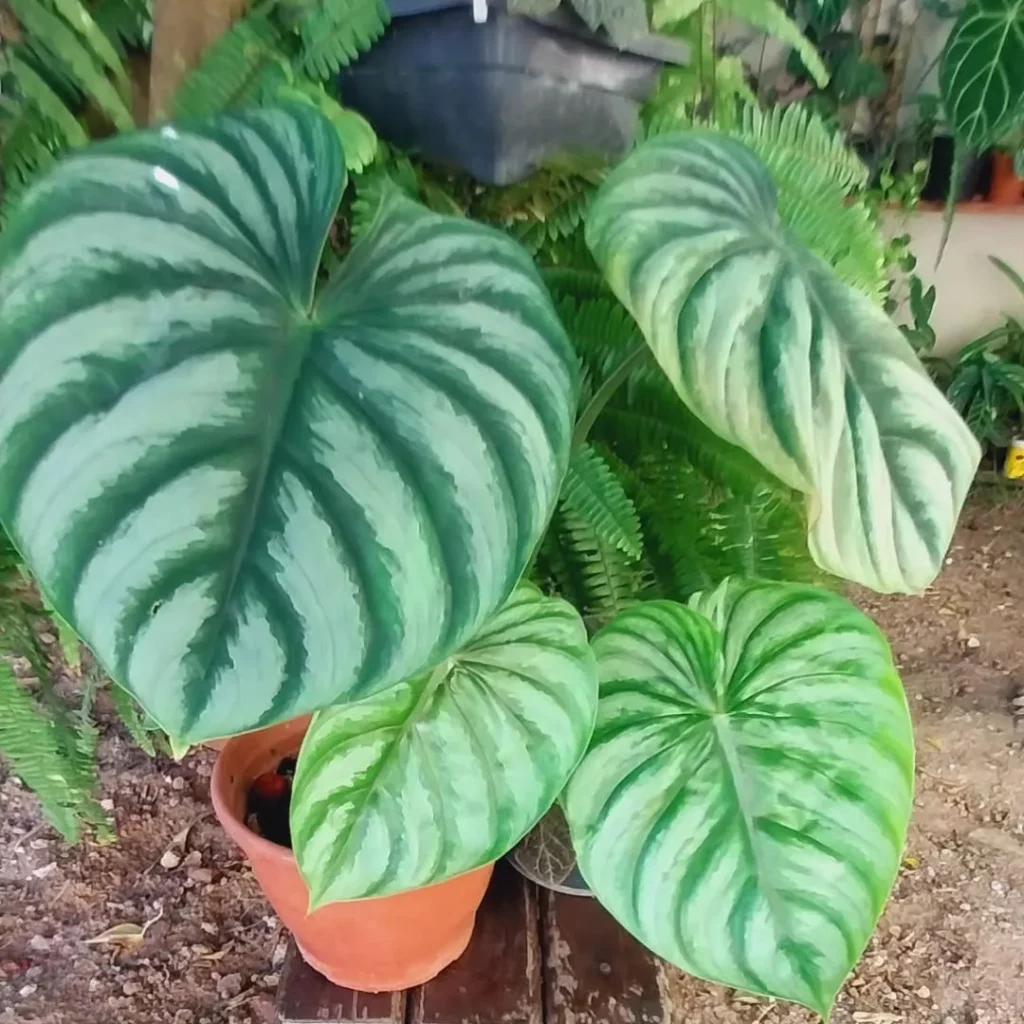

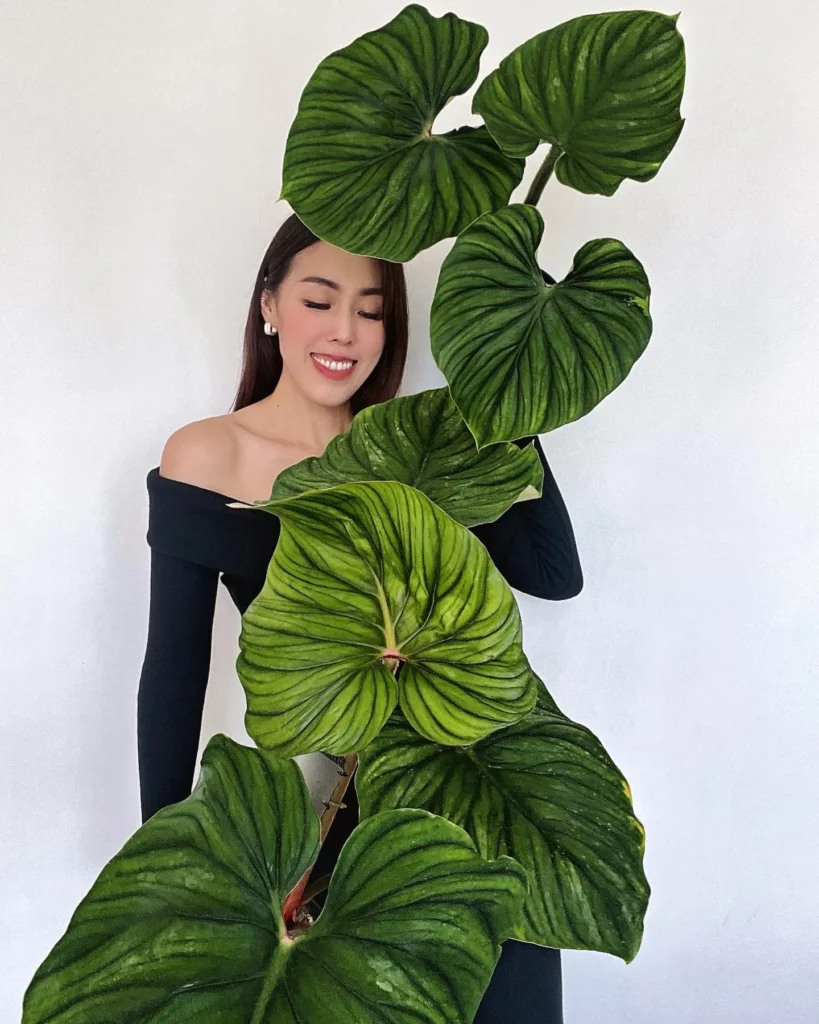
A remarkable species with large, rippled leaves that have a soft, velvety texture.
- Leaf Color: Deep green.
- Leaf Size: Large.
- Growth Habit: Creeping.
- Availability: Less common.
Philodendron Mamei



This species stands out with its silver-patterned markings on large green leaves, giving it a shimmery appearance.
- Leaf Color: Green with silver patterns.
- Leaf Size: Large.
- Growth Habit: Creeping.
- Availability: Moderate.
Philodendron Splendid
A beautiful hybrid known for its metallic silver leaves contrasted by deep green veins.
No products found.
- Leaf Color: Metallic silver with deep green veins.
- Leaf Size: Medium to large.
- Growth Habit: Vining.
- Availability: Less common.
Philodendron Camposportoanum



Distinguished by its elongated, narrow leaves with gentle ripples along the edges.
- Leaf Color: Green.
- Leaf Size: Medium to long.
- Growth Habit: Vining.
- Availability: Moderate.
Philodendron Ring of Fire
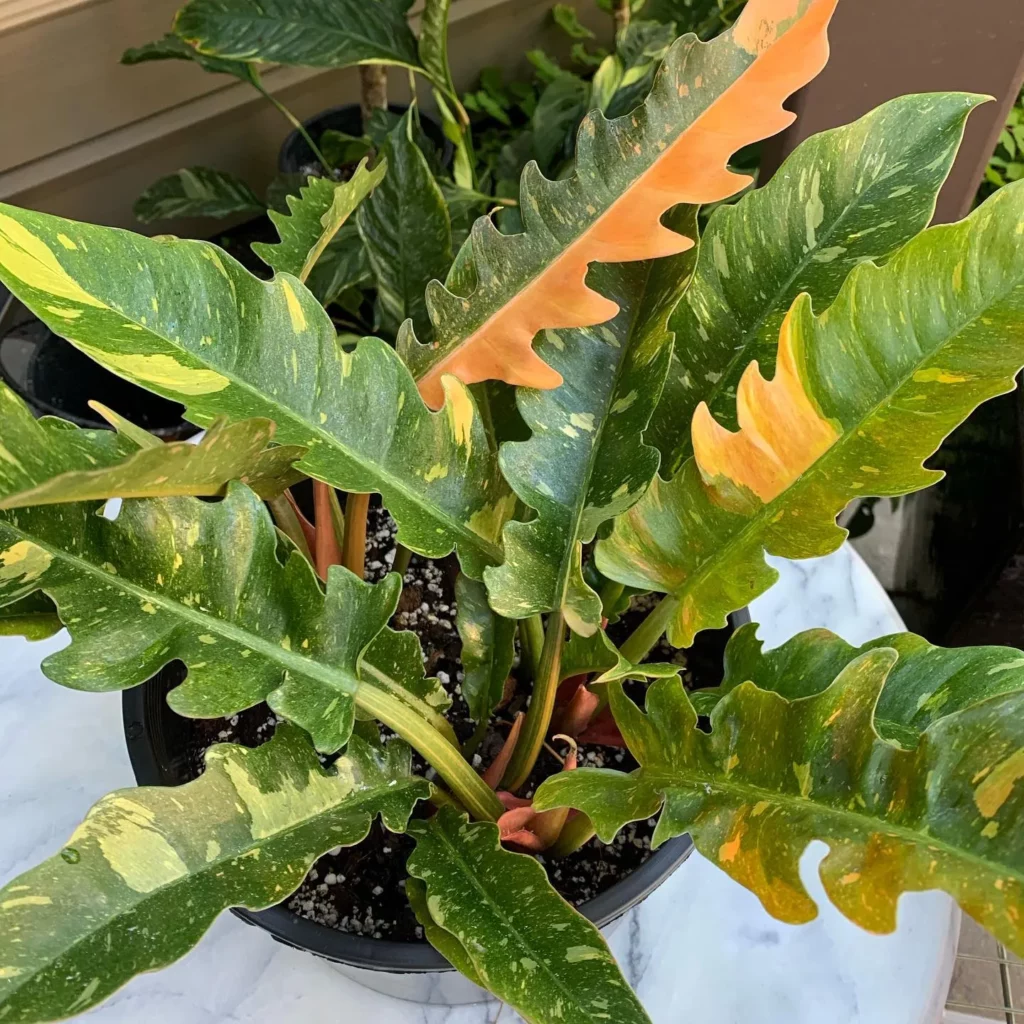
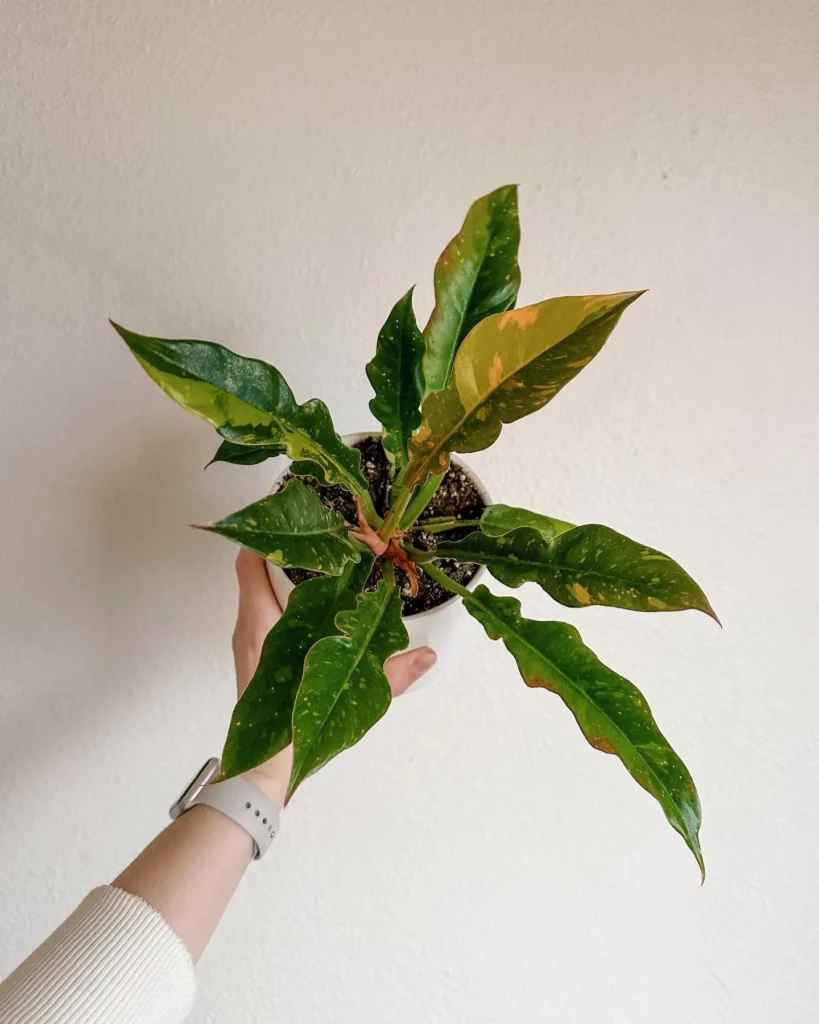

As the name suggests, this variety has a fiery appearance, with leaves showcasing a blend of yellow, green, and red hues.
No products found.
- Leaf Color: Blend of yellow, green, and red.
- Leaf Size: Medium.
- Growth Habit: Upright.
- Availability: Less common.
Philodendron Gloriosum



Renowned for its large, heart-shaped, velvety green leaves accentuated by white veins.
- Leaf Color: Green with white veins.
- Leaf Size: Large.
- Growth Habit: Creeping.
- Availability: Fairly common.
Philodendron Giganteum



As the name implies, this plant boasts some of the largest leaves in the Philodendron genus, evoking a lush tropical ambiance.
- Leaf Color: Deep green.
- Leaf Size: Very large, capable of growing several feet in length.
- Growth Habit: Upright to sprawling.
- Availability: Moderate.
Philodendron Billietiae
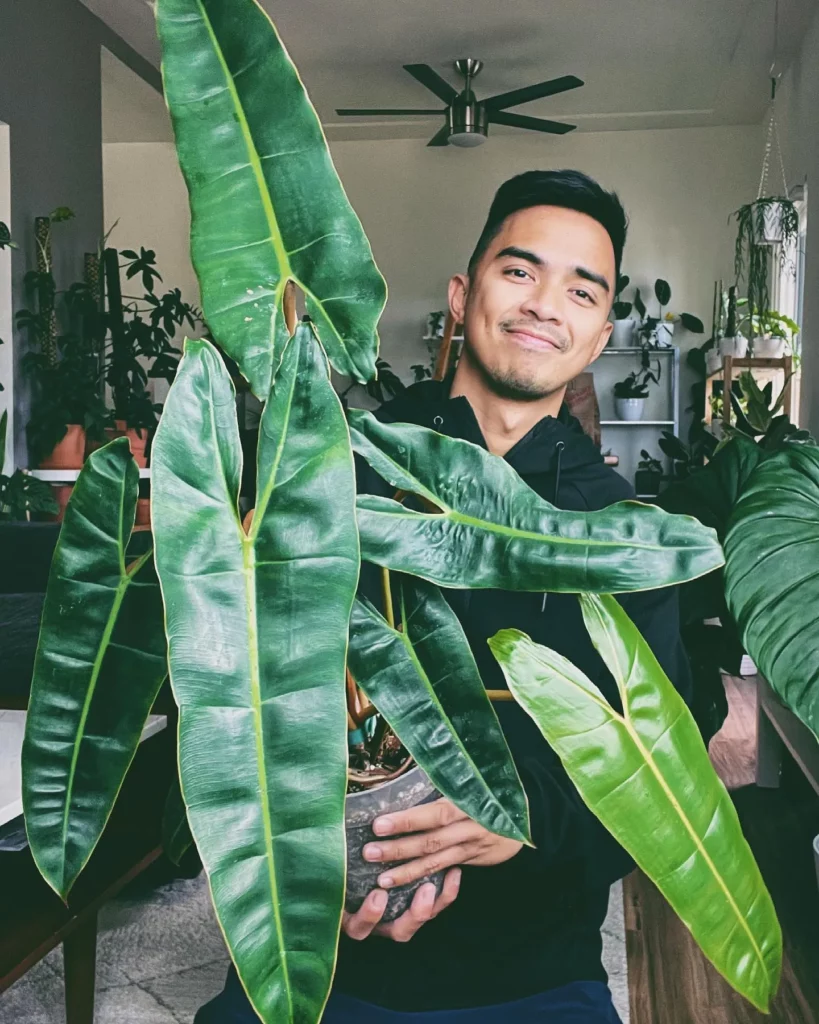

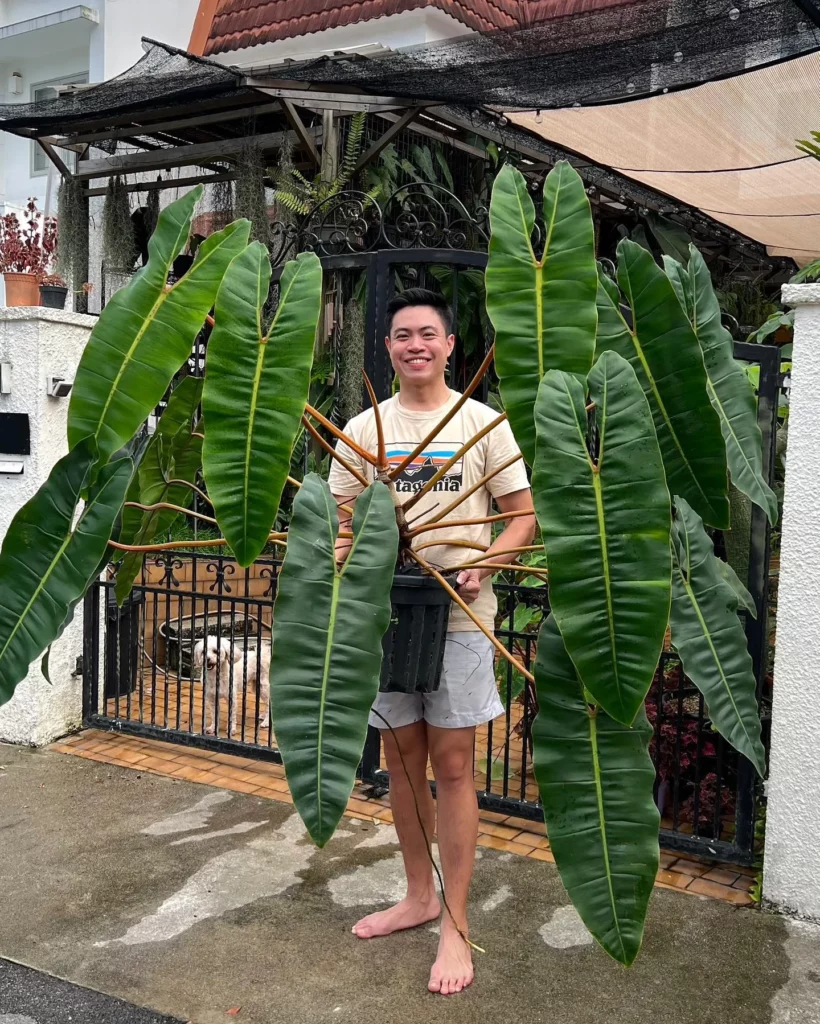
Distinctive for its long green leaves and striking, elongated, orange-hued petioles.
- Leaf Color: Green.
- Leaf Size: Long.
- Growth Habit: Upright with a tendency to sprawl.
- Availability: Moderate.
Philodendron Moonlight
This hybrid variety is beloved for its bright, lime-green leaves which appear to glow.
No products found.
- Leaf Color: Luminescent lime-green.
- Leaf Size: Medium.
- Growth Habit: Upright.
- Availability: Commonly available.
Philodendron Bipennifolium
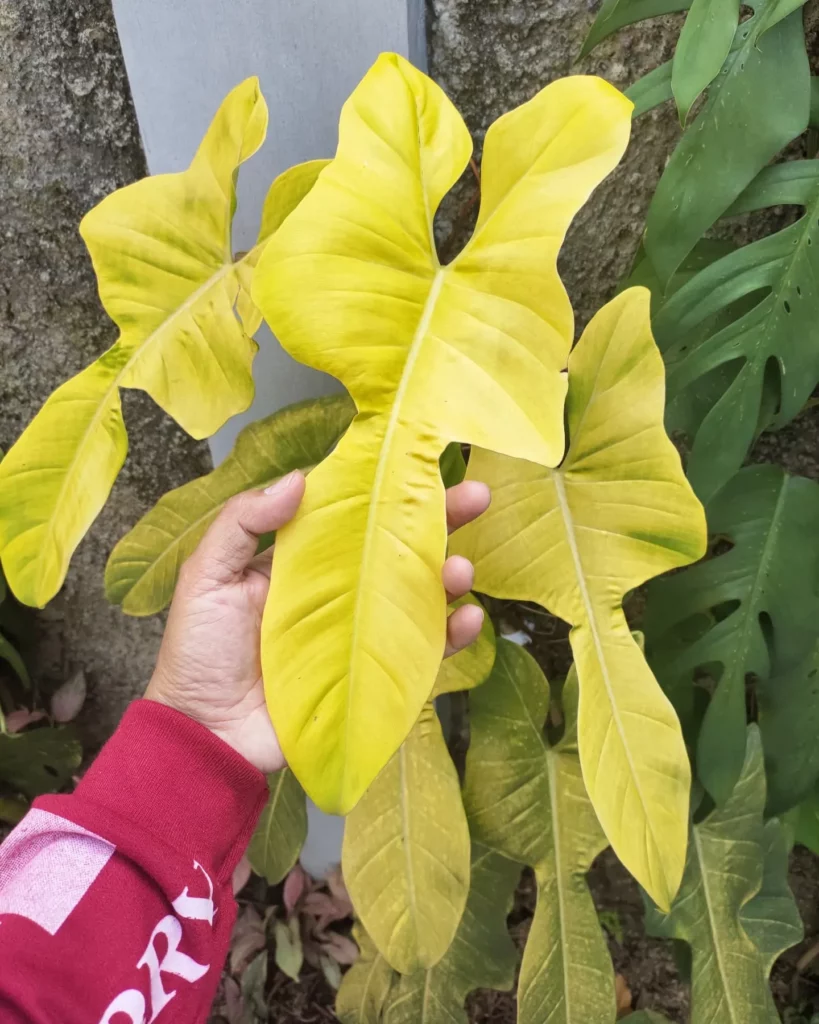


Often referred to as the Horse Head Plant, its leaves have a unique shape reminiscent of a fiddle or violin.
- Leaf Color: Green.
- Leaf Size: Medium to large.
- Growth Habit: Climbing or trailing.
- Availability: Common.
Philodendron Mayoi
A standout species with a unique leaf shape, featuring pronounced lobes and a velvety texture.
- Leaf Color: Deep green.
- Leaf Size: Large.
- Growth Habit: Upright.
- Availability: Less common.
Lemon Lime Philodendron



This variety is characterized by its vibrant neon-green leaves that maintain their color throughout maturity.
No products found.
- Leaf Color: Neon-green.
- Leaf Size: Medium.
- Growth Habit: Vining or trailing.
- Availability: Commonly available.
Philodendron Rugosum
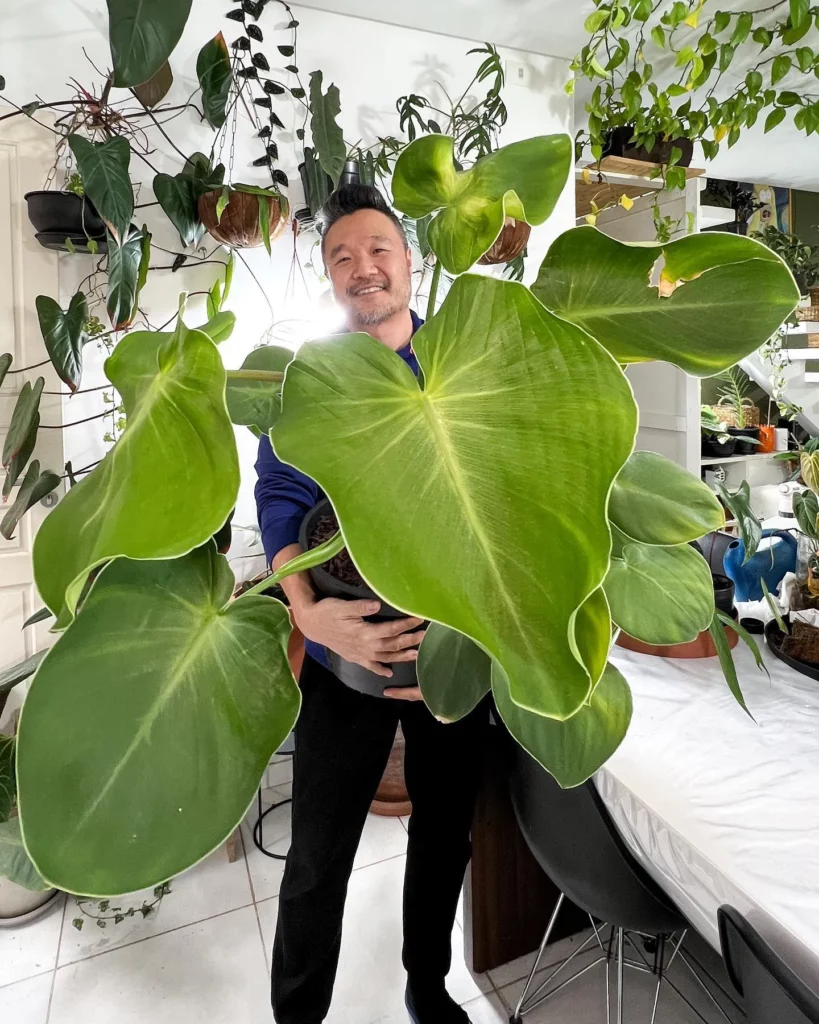
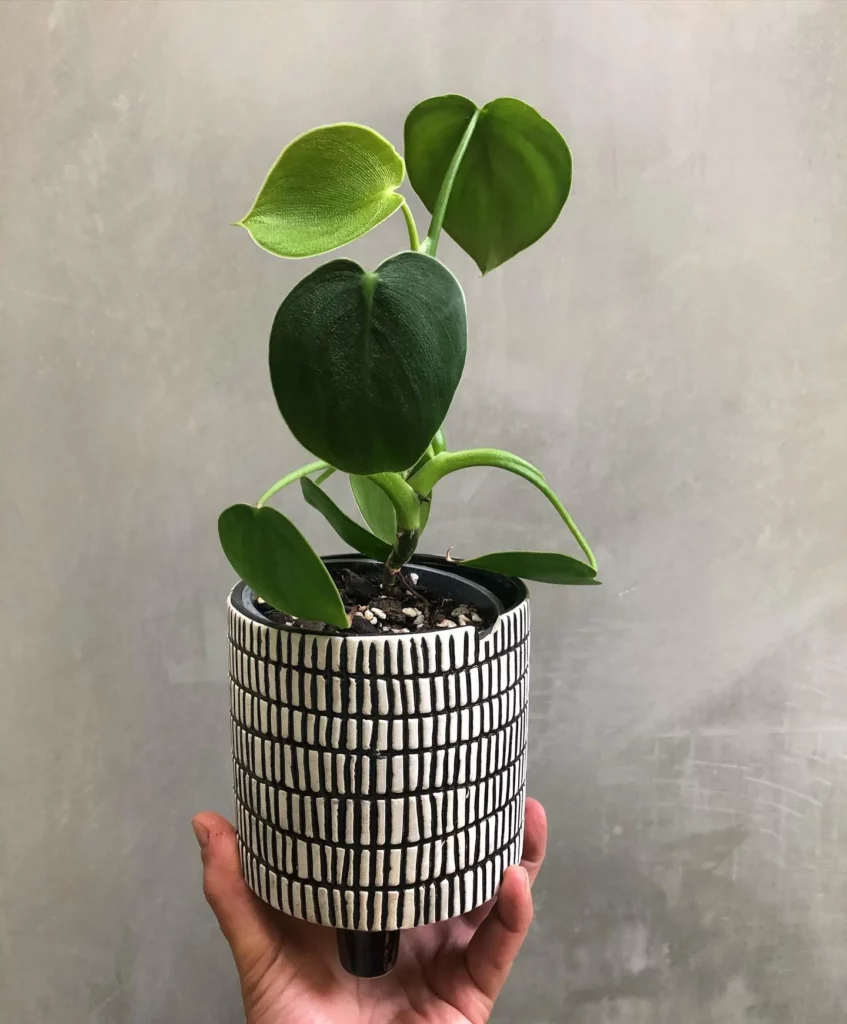
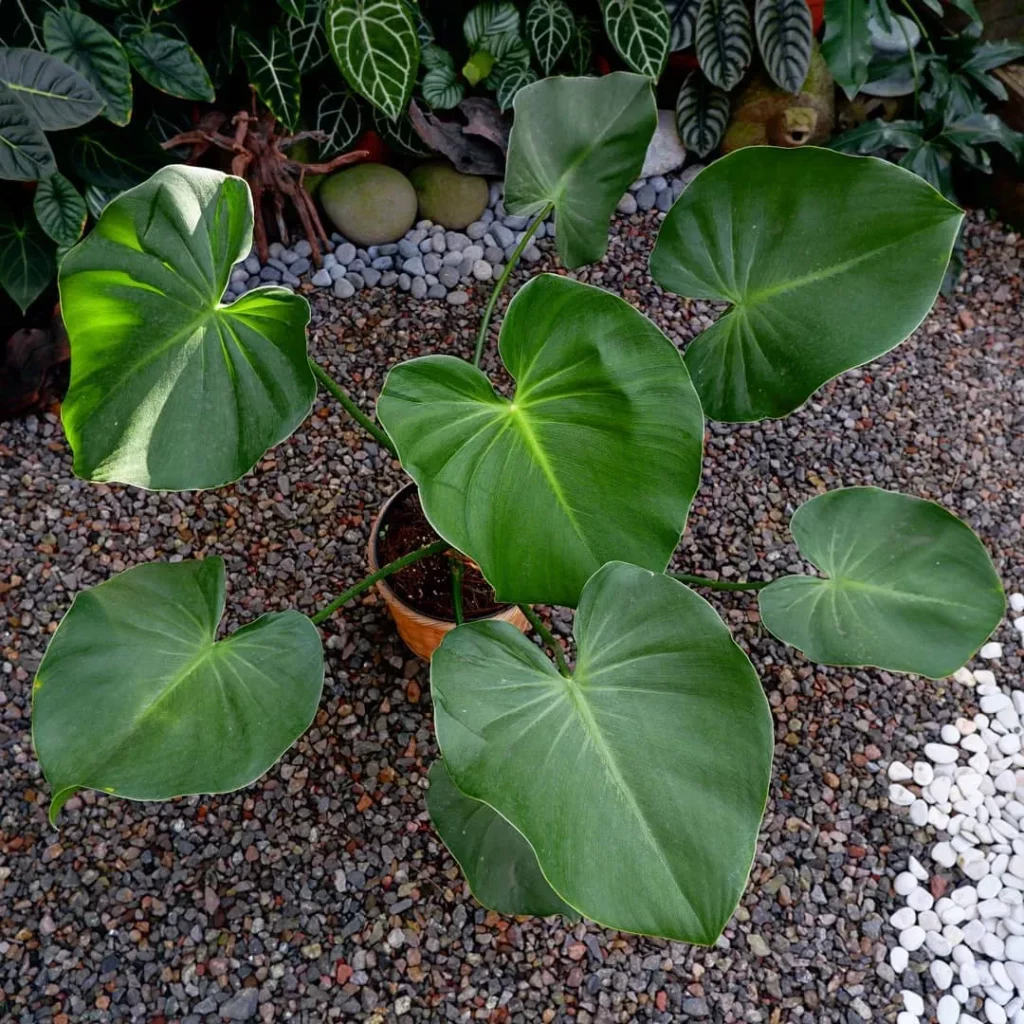
Recognizable by its intriguing rough, textured leaves which contrast with the typically smooth leaves of other Philodendrons.
- Leaf Color: Green.
- Leaf Size: Medium.
- Growth Habit: Upright.
- Availability: Less common.
Philodendron Rojo Congo

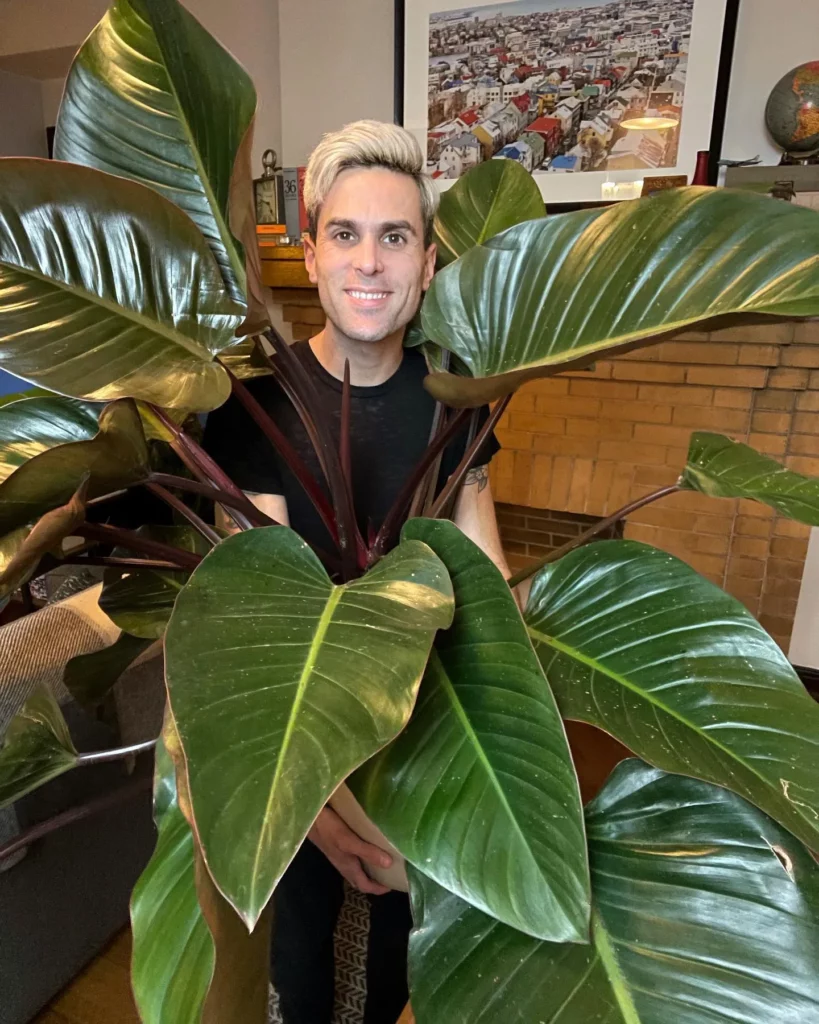
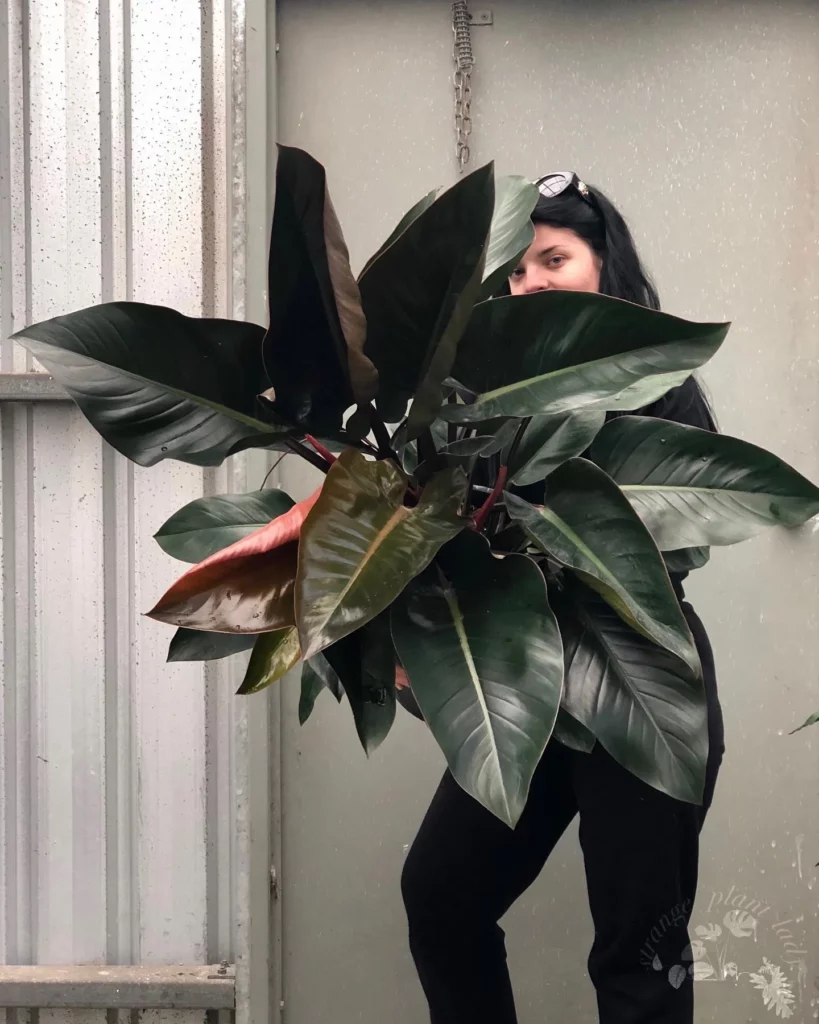
Features broad leaves that begin as a deep red when young and gradually transition to a dark green with age. The petioles retain their red hue.
- Leaf Color: Starts as deep red, matures to dark green.
- Leaf Size: Large.
- Growth Habit: Upright.
- Availability: Common.
Philodendron Brandtianum


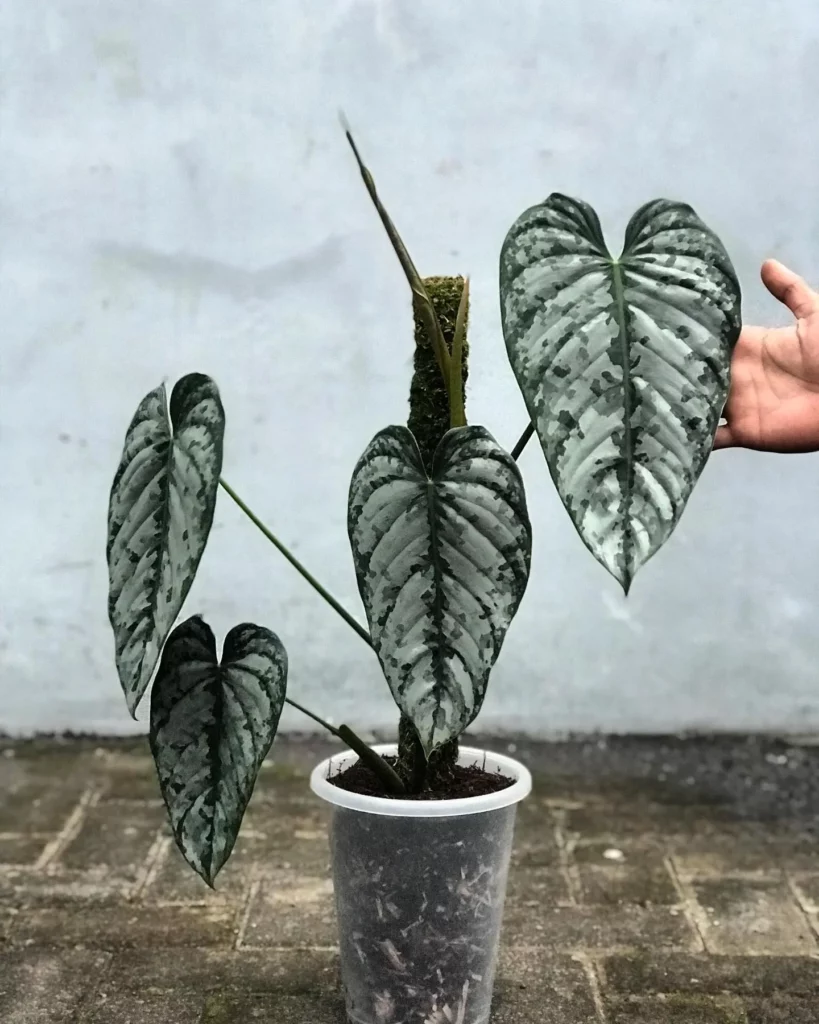
Distinguished by its leaves, which have a unique mosaic-like pattern, blending shades of green with silver.
- Leaf Color: Green with silver patterns.
- Leaf Size: Medium.
- Growth Habit: Climbing.
- Availability: Moderate.
Philodendron Goeldii
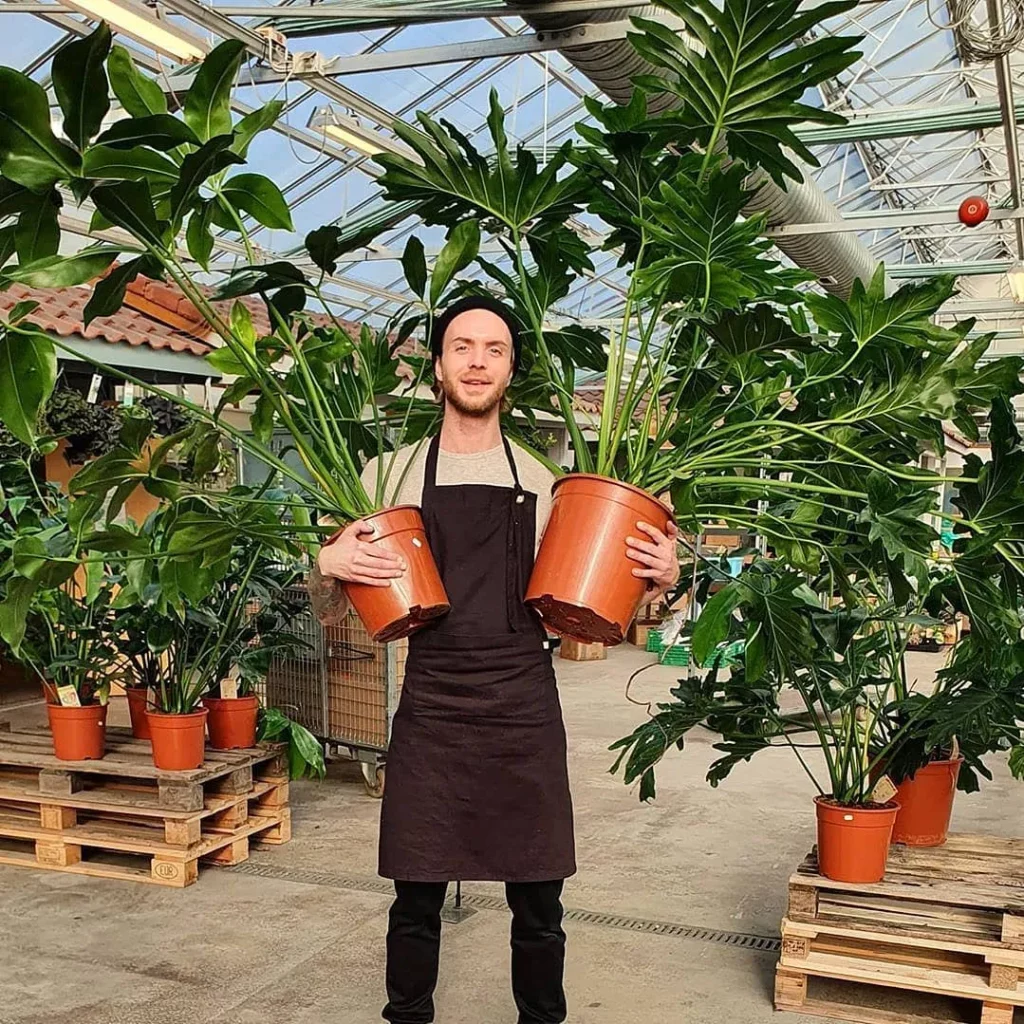


Also known as the Spiral Philodendron, it’s admired for its leaves that grow in a pinwheel arrangement, creating a spiral effect.
- Leaf Color: Green.
- Leaf Size: Medium to large.
- Growth Habit: Upright.
- Availability: Less common.
Philodendron Verrucosum
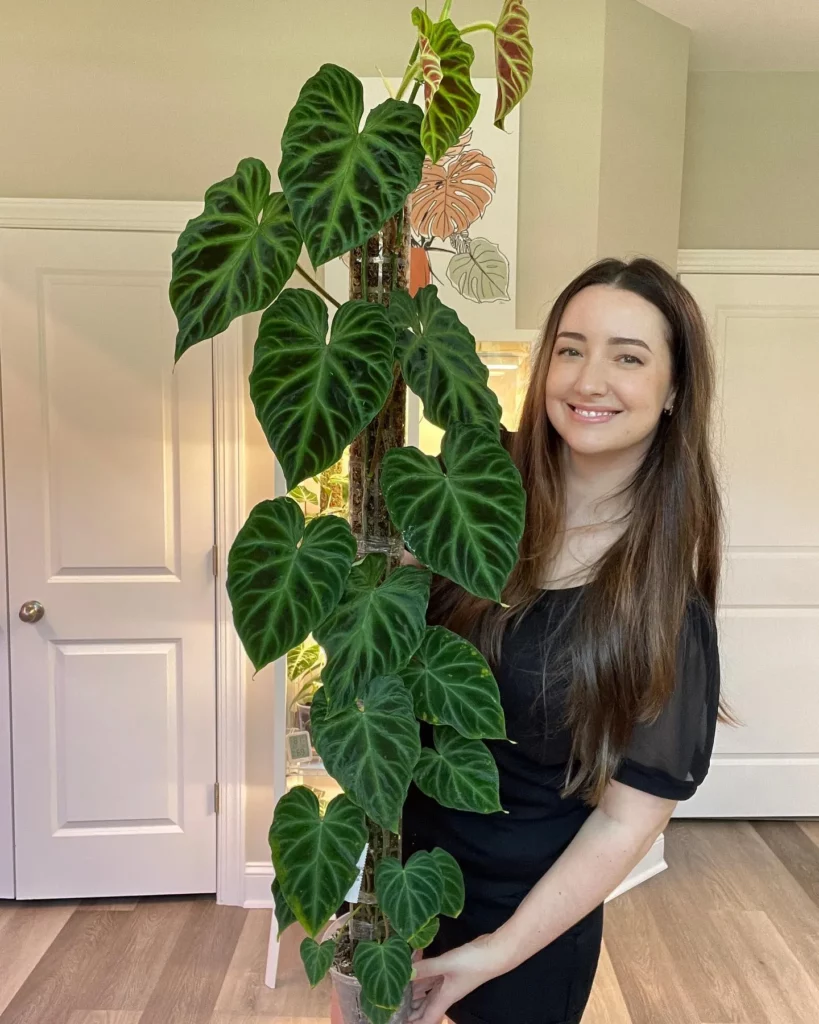


An elegant species known for its velvety leaves with bright veins. The petioles often have a unique, hairy texture.
- Leaf Color: Deep green with bright veins.
- Leaf Size: Medium to large.
- Growth Habit: Climbing.
- Availability: Less common.
Philodendron Pink Princess



This variety has achieved cult status among plant enthusiasts due to its dark green to almost black leaves with striking pink variegation.
- Leaf Color: Dark green to black with pink variegation.
- Leaf Size: Medium.
- Growth Habit: Upright.
- Availability: Rare and highly sought after.
Philodendron Cordatum



A classic heart-leaf Philodendron, it’s popular for its vining growth and heart-shaped leaves.
- Leaf Color: Green.
- Leaf Size: Small to medium.
- Growth Habit: Trailing or climbing.
- Availability: Commonly available.
Strawberry Shake Philodendron



A captivating variety with variegated leaves showcasing shades of pink, red, and green.
- Leaf Color: Variegated with pink, red, and green.
- Leaf Size: Medium.
- Growth Habit: Upright.
- Availability: Less common.
Philodendron Grazielae



This species stands out with its rounded, heart-shaped leaves and compact growth habit.
- Leaf Color: Green.
- Leaf Size: Small to medium.
- Growth Habit: Compact and bushy.
- Availability: Moderate.
Philodendron Brasil
A popular variegated variety with green leaves featuring a central yellow stripe.
- Leaf Color: Green with central yellow stripe.
- Leaf Size: Medium.
- Growth Habit: Vining or trailing.
- Availability: Commonly available.
Philodendron Xanadu

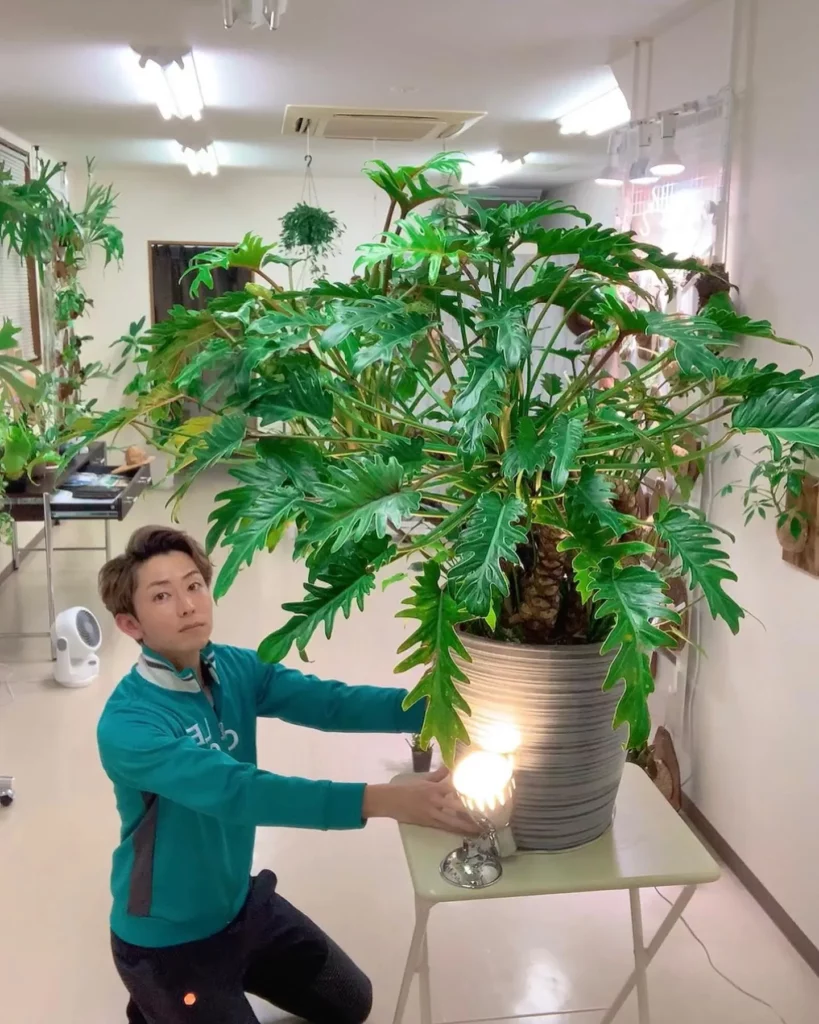

Characterized by its deeply lobed leaves and dense growth, it’s often used as a landscape plant in tropical regions.
- Leaf Color: Green.
- Leaf Size: Medium to large.
- Growth Habit: Upright and bushy.
- Availability: Common.
Philodendron White Knight



A rare variety known for its dark green leaves with striking white variegation.
- Leaf Color: Dark green with white variegation.
- Leaf Size: Medium.
- Growth Habit: Upright.
- Availability: Rare and sought after.
Philodendron Selloum



Also known as Philodendron Hope, it’s recognized by its large, deeply lobed leaves.
- Leaf Color: Green.
- Leaf Size: Large.
- Growth Habit: Bushy and sprawling.
- Availability: Commonly available.
Philodendron Hederaceum



A classic heart-leaf Philodendron, it’s a favorite for its vining growth and heart-shaped leaves.
- Leaf Color: Green.
- Leaf Size: Small to medium.
- Growth Habit: Trailing or climbing.
- Availability: Commonly available.
Philodendron Painted Lady
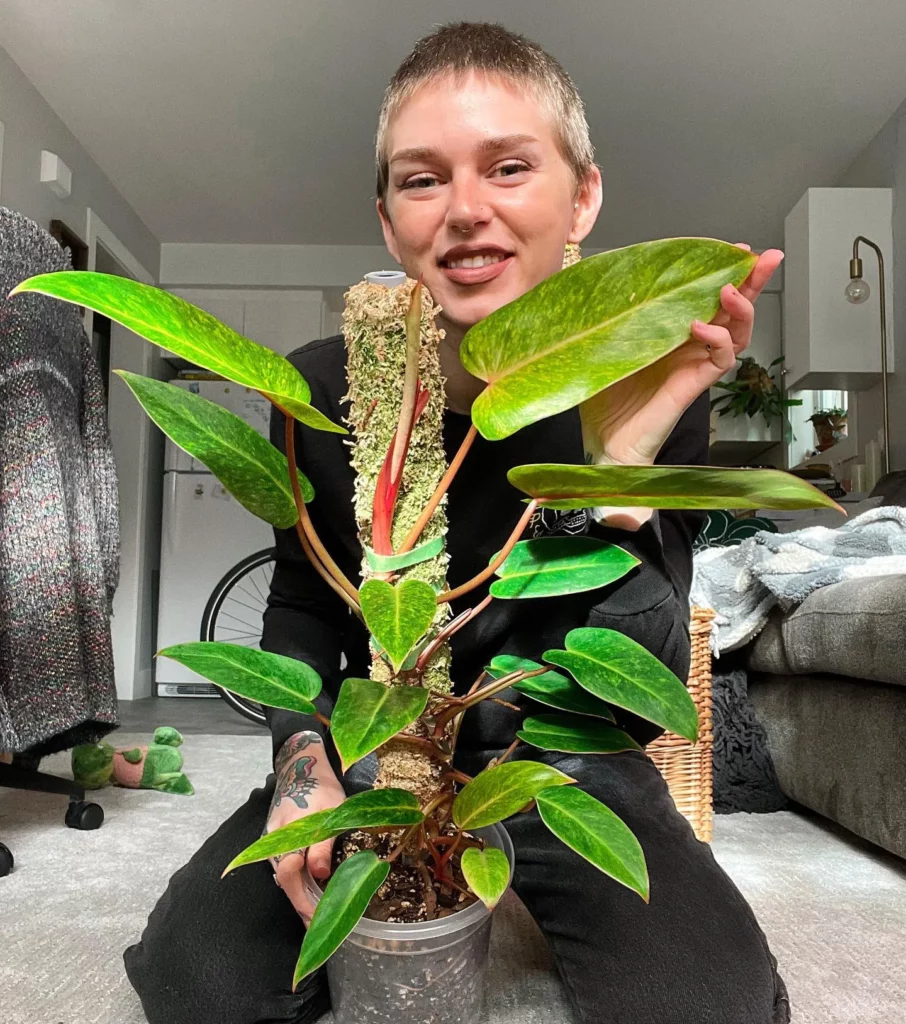
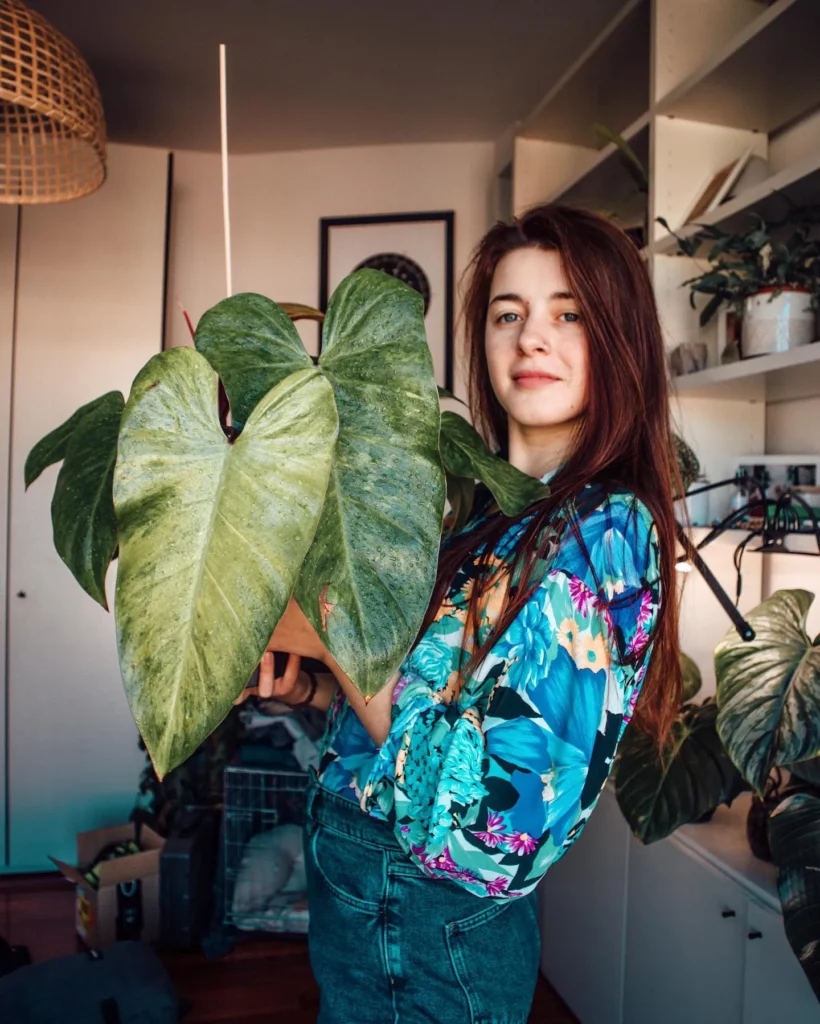
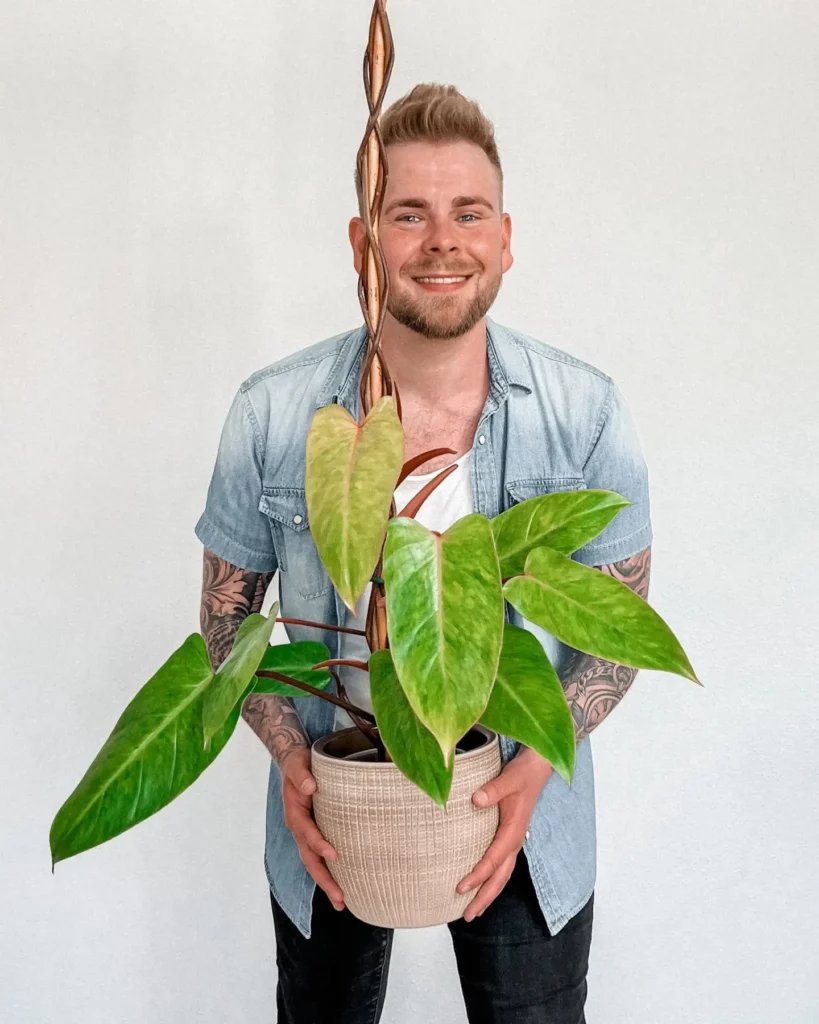
This variety is recognized for its elongated leaves with a unique pattern of yellow and green, giving it a “painted” appearance.
- Leaf Color: Green with yellow patterns.
- Leaf Size: Medium to large.
- Growth Habit: Upright.
- Availability: Moderate.
Silver Sword Philodendron Hastatum



Known for its elongated, silvery-blue leaves, this Philodendron exudes a metallic sheen, making it stand out in any collection.
- Leaf Color: Silvery-blue.
- Leaf Size: Medium to long.
- Growth Habit: Climbing.
- Availability: Moderate.
Philodendron Squamiferum



Distinctive for its red, hairy petioles and green, lobed leaves, it brings a unique texture to any plant collection.
- Leaf Color: Green.
- Leaf Size: Medium.
- Growth Habit: Climbing.
- Availability: Less common.
Philodendron Red Emerald (Philodendron erubescens)



Characterized by its dark green leaves with a reddish underside and red stems, it offers a beautiful contrast.
- Leaf Color: Dark green with a reddish underside.
- Leaf Size: Medium to large.
- Growth Habit: Climbing.
- Availability: Common.
Philodendron Imperial Red (Philodendron erubescens ‘Imperial Red’)
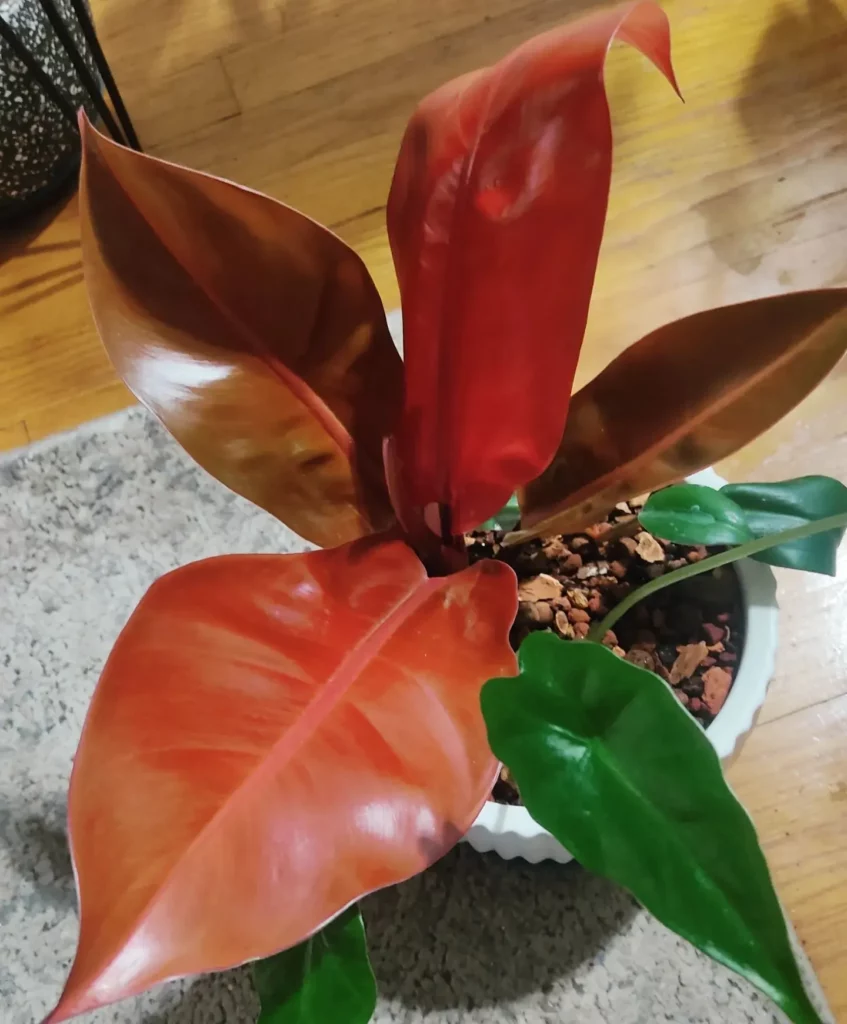
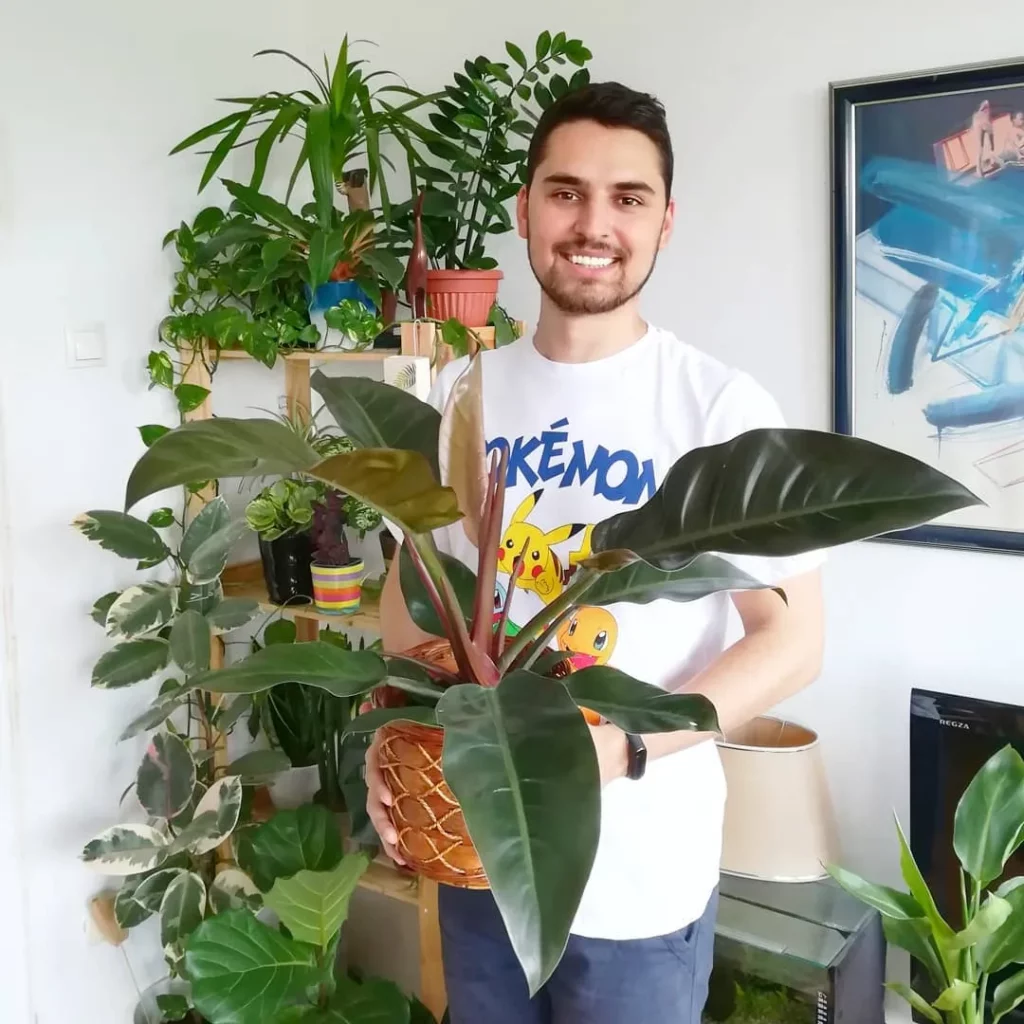
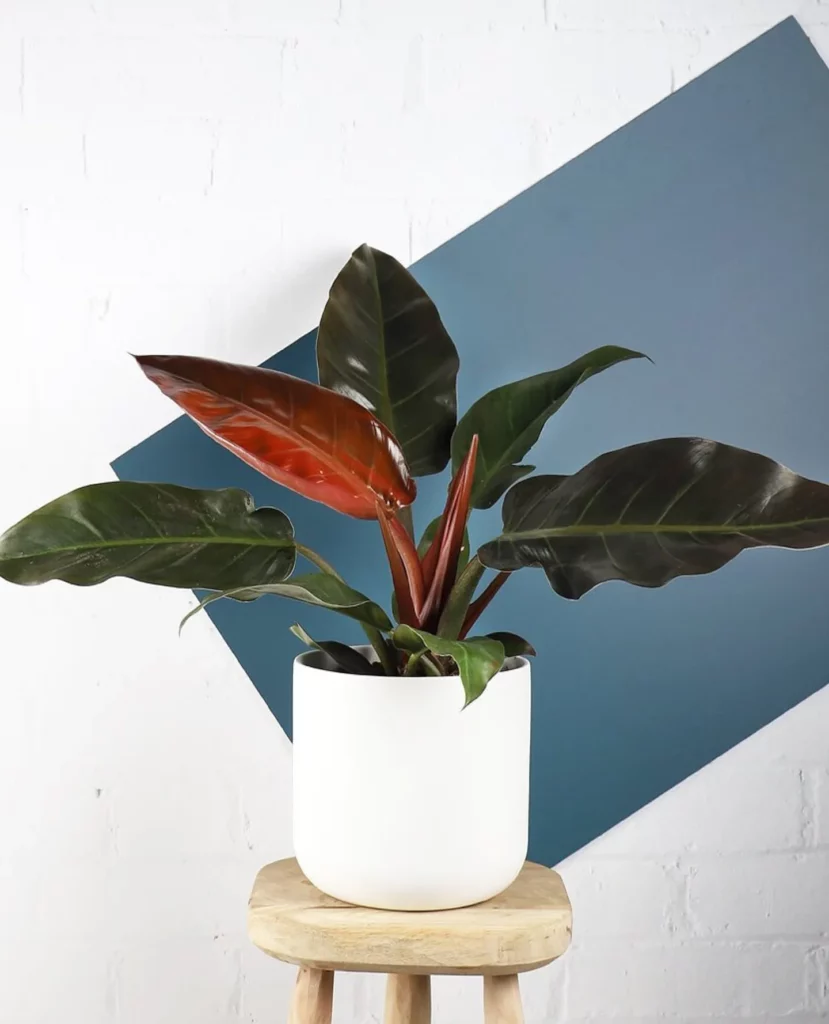
Known for its large, glossy, deep red to burgundy leaves, this variety adds a touch of royalty to any space.
- Leaf Color: Deep red to burgundy.
- Leaf Size: Large.
- Growth Habit: Upright.
- Availability: Common.
Philodendron Silver Stripe
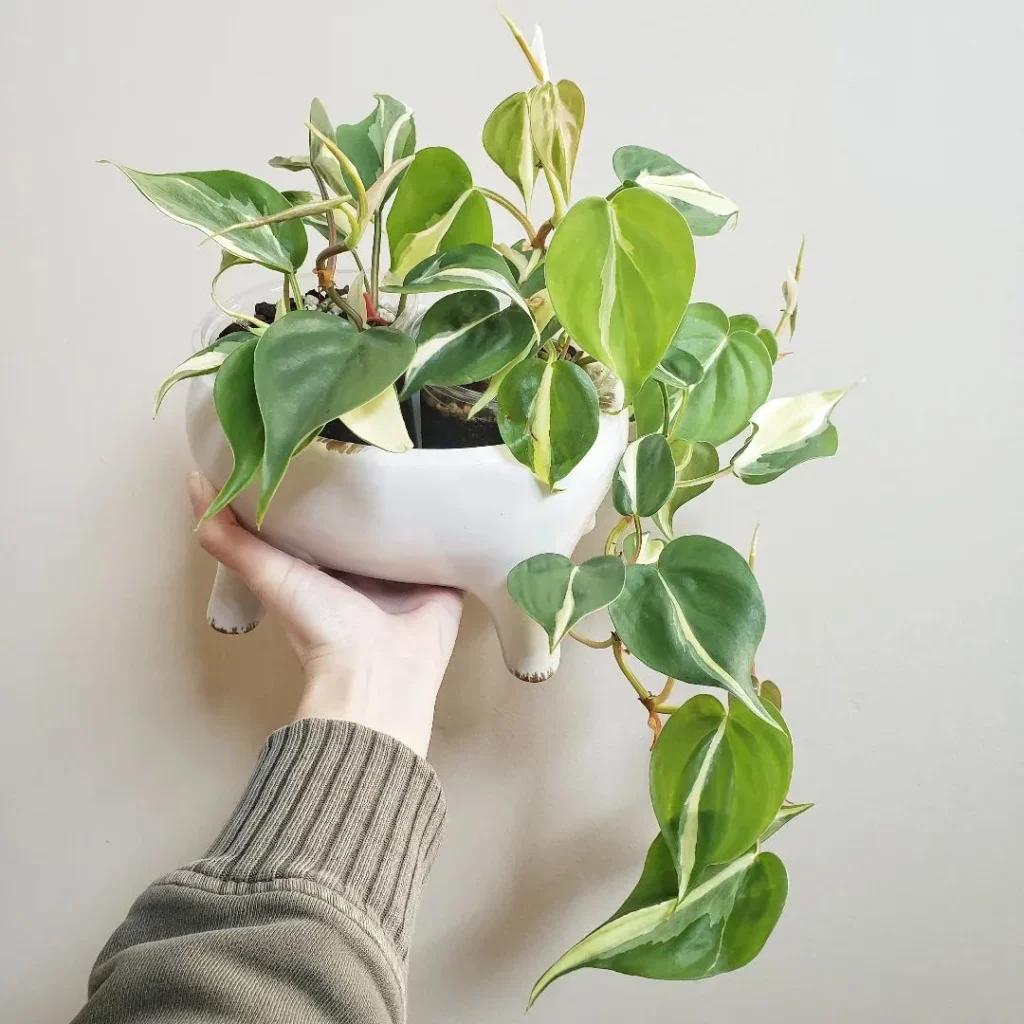
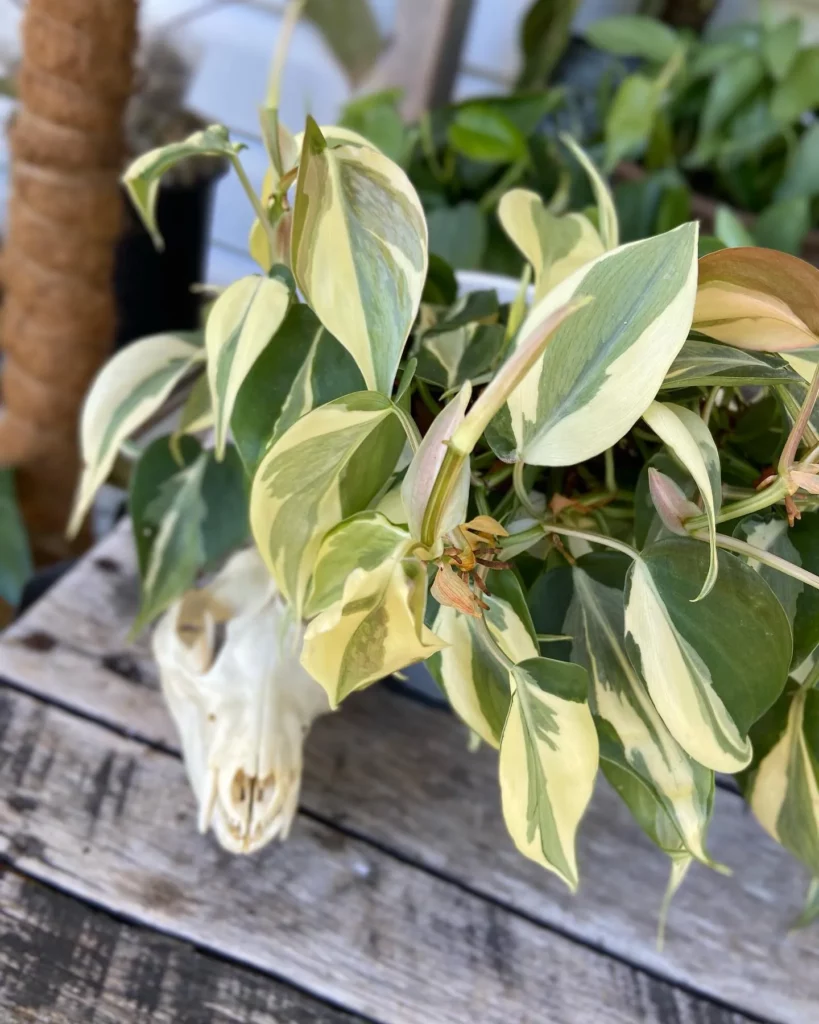
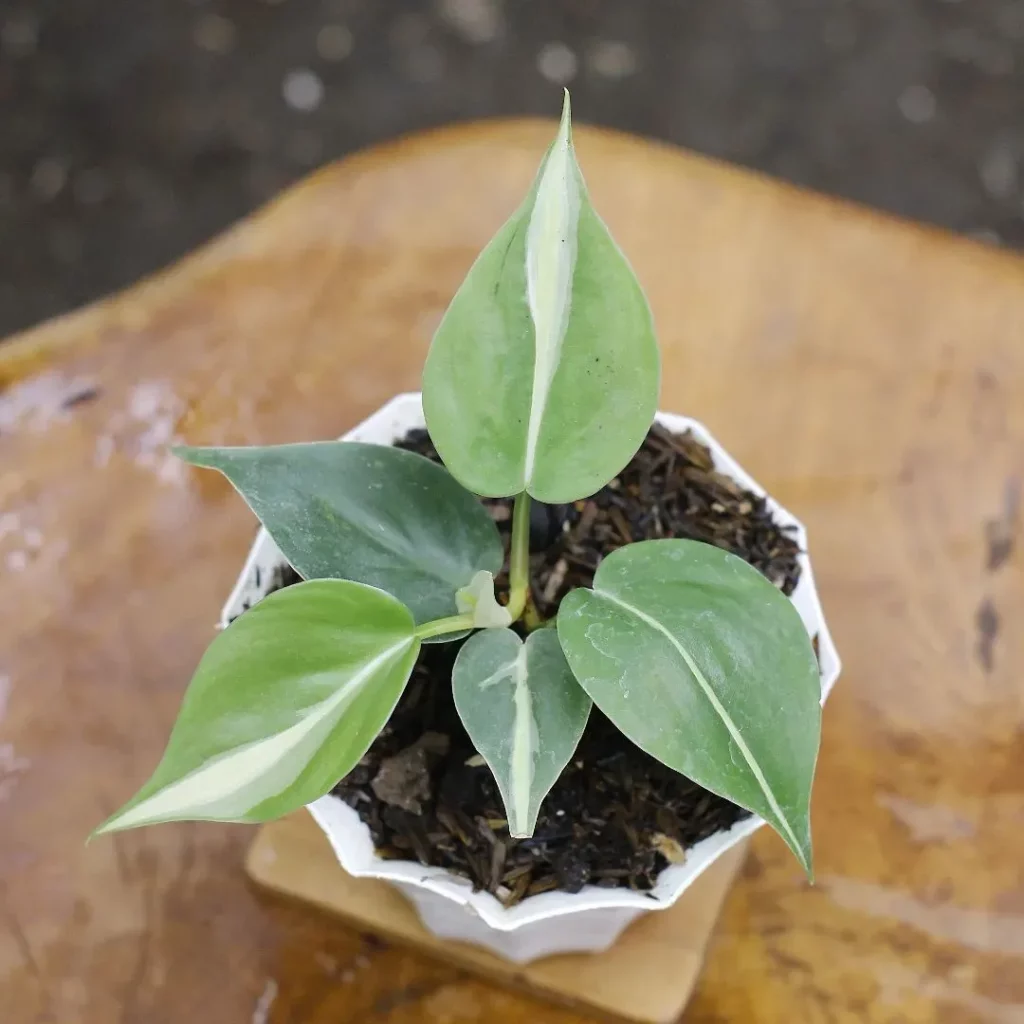
This variety is recognized for its green leaves adorned with subtle silver stripes, adding a touch of elegance.
- Leaf Color: Green with silver stripes.
- Leaf Size: Medium.
- Growth Habit: Vining.
- Availability: Moderate.
Philodendron Black Cardinal
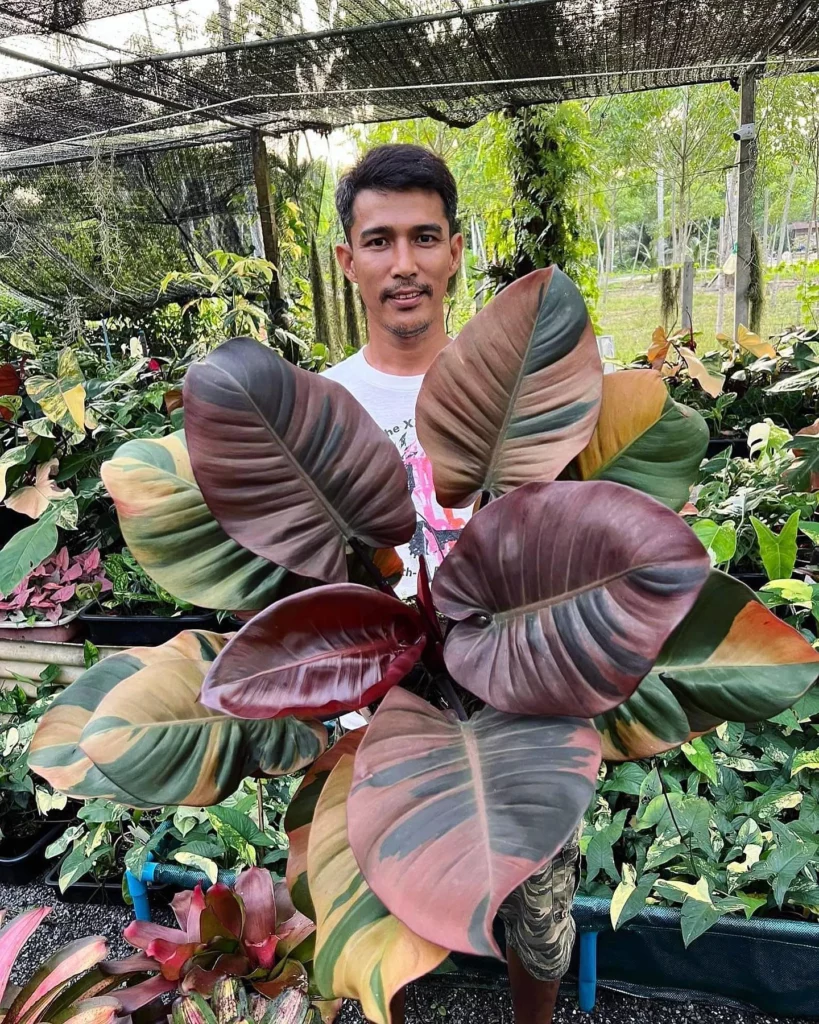
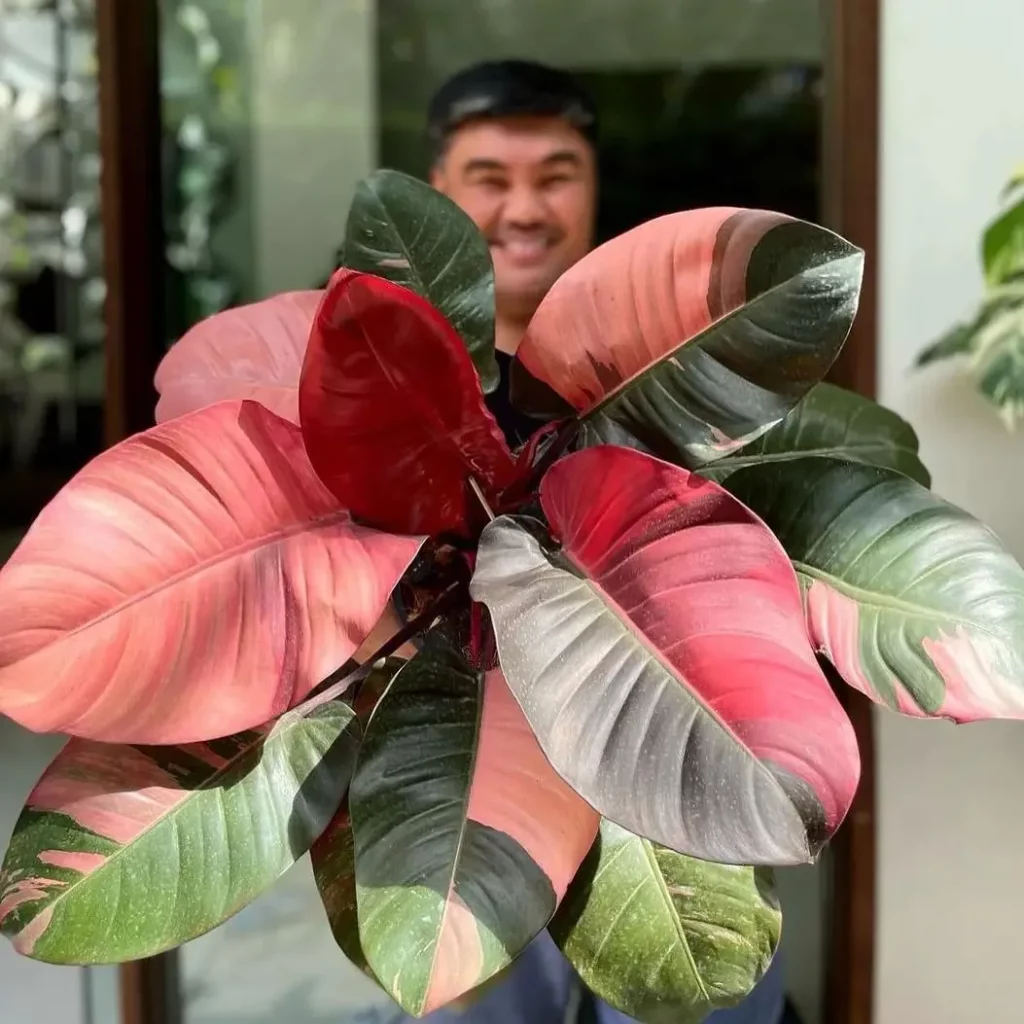
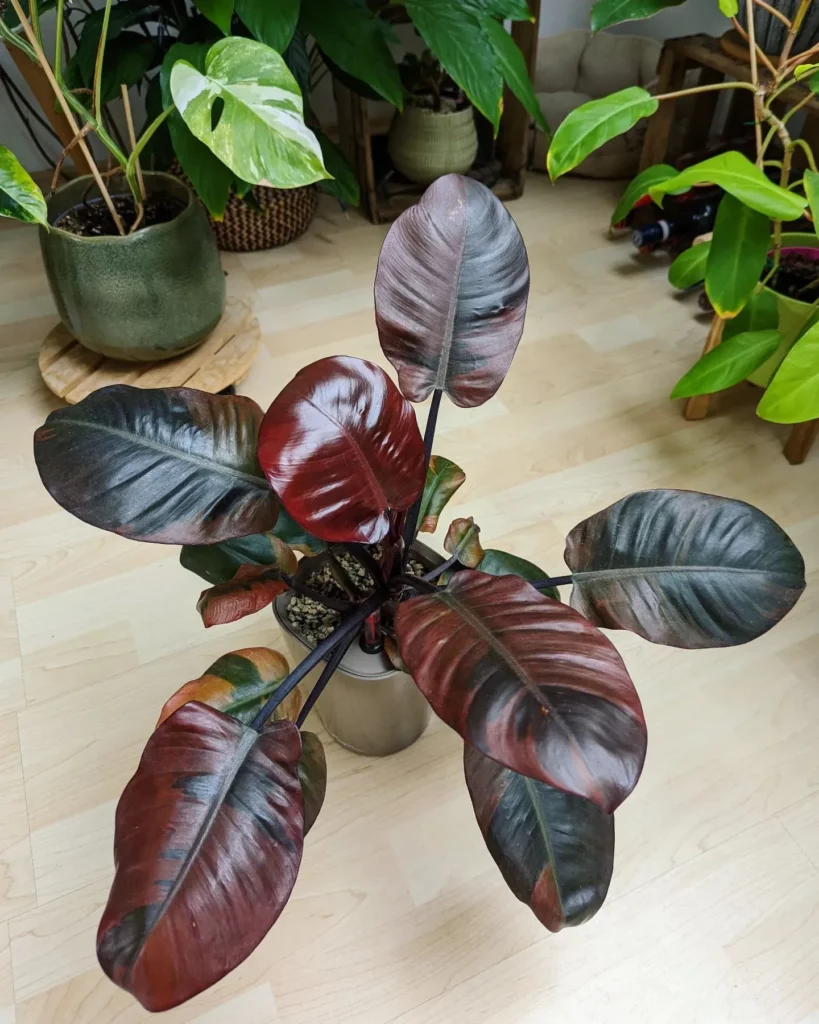
Featuring stunning dark green to almost black leaves, this Philodendron variety is a dramatic addition to any plant collection.
- Leaf Color: Dark green to black.
- Leaf Size: Medium to large.
- Growth Habit: Upright.
- Availability: Common.
Philodendron Narrow (Philodendron angustisectum)



This species stands out with its long, slender leaves that have a unique serrated appearance.
- Leaf Color: Green.
- Leaf Size: Long and narrow.
- Growth Habit: Upright.
- Availability: Less common.
Philodendron Scandens (Philodendron hederaceum)



Another name for the classic heart-leaf Philodendron, it’s a favorite among enthusiasts for its vining growth and heart-shaped leaves.
- Leaf Color: Green.
- Leaf Size: Small to medium.
- Growth Habit: Trailing or climbing.
- Availability: Commonly available.
Philodendron Gigas
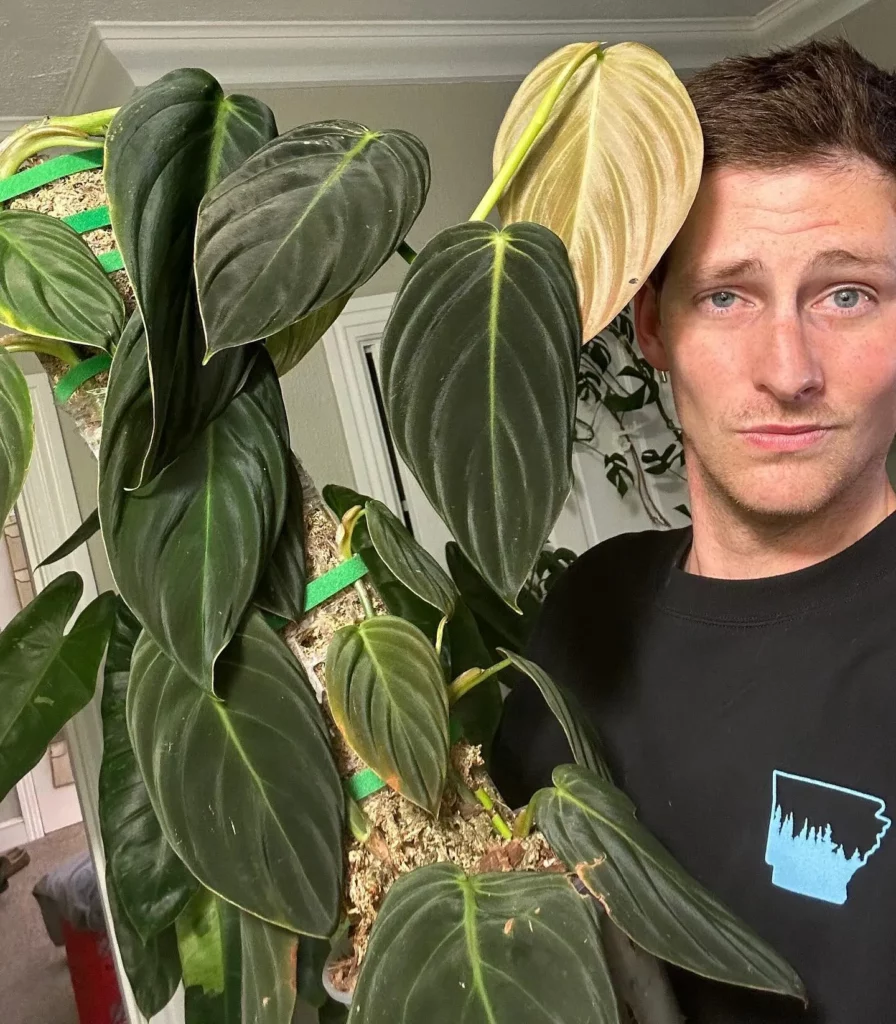

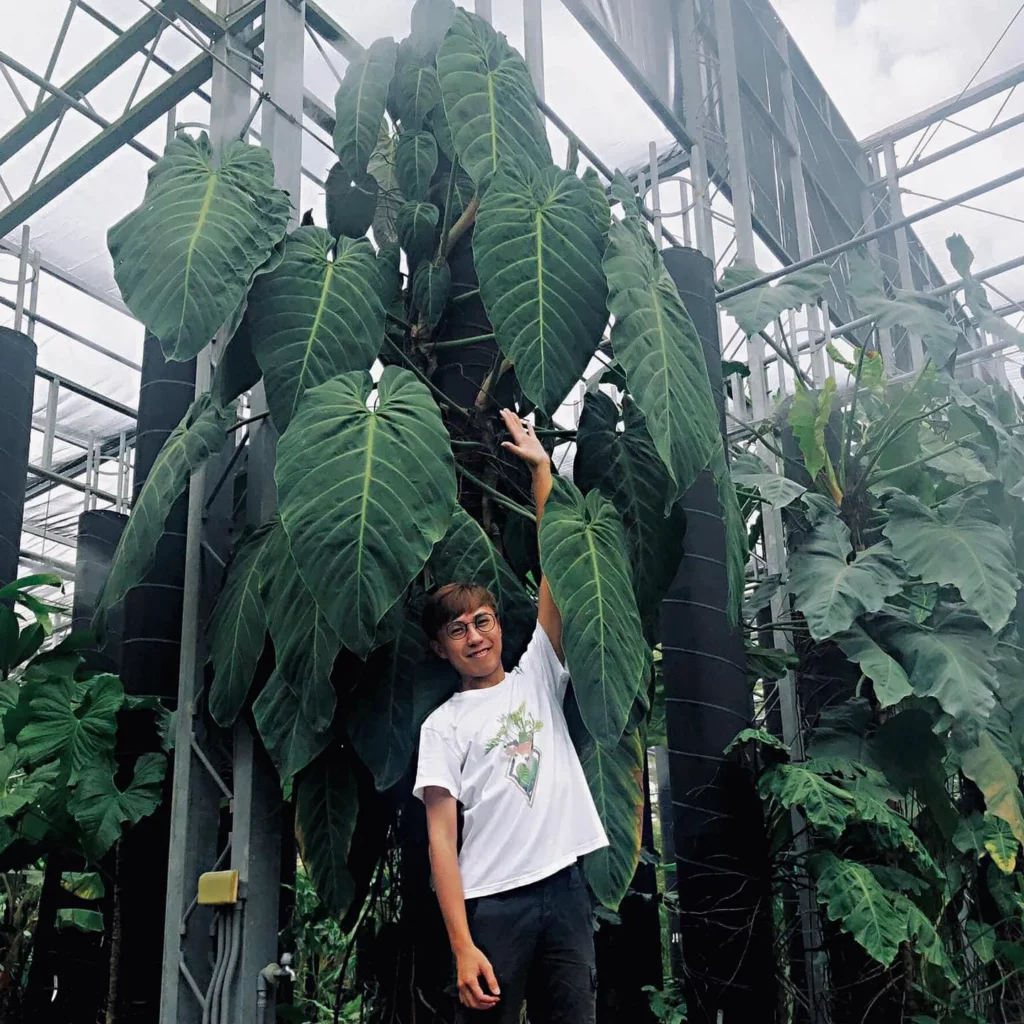
With its large, velvety, dark green leaves, this species is a showstopper in any collection.
- Leaf Color: Dark green.
- Leaf Size: Large.
- Growth Habit: Climbing.
- Availability: Less common.
Philodendron Squamicaule



This unique species stands out with its thick, chunky stems and deep green, heavily textured leaves.
- Leaf Color: Deep green.
- Leaf Size: Medium.
- Growth Habit: Upright.
- Availability: Rare.
Philodendron Spiritus Sancti
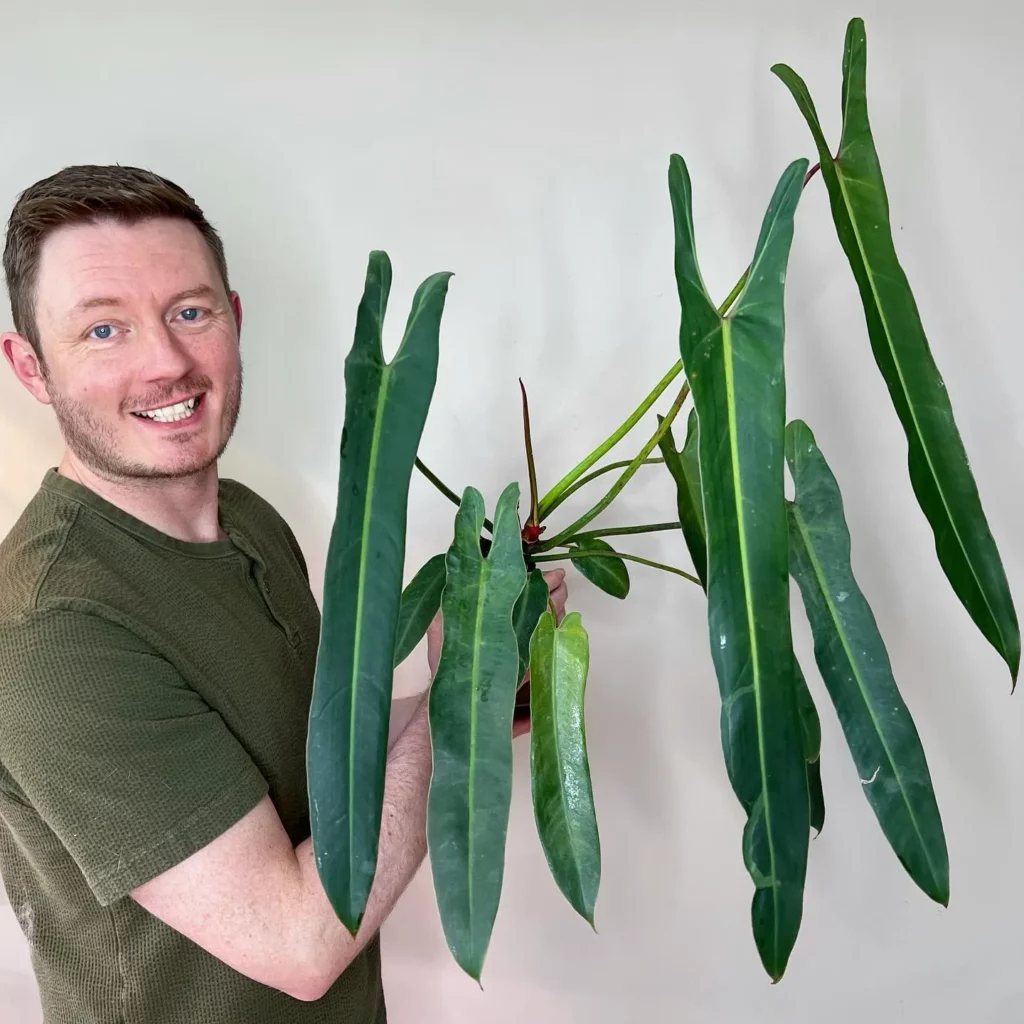
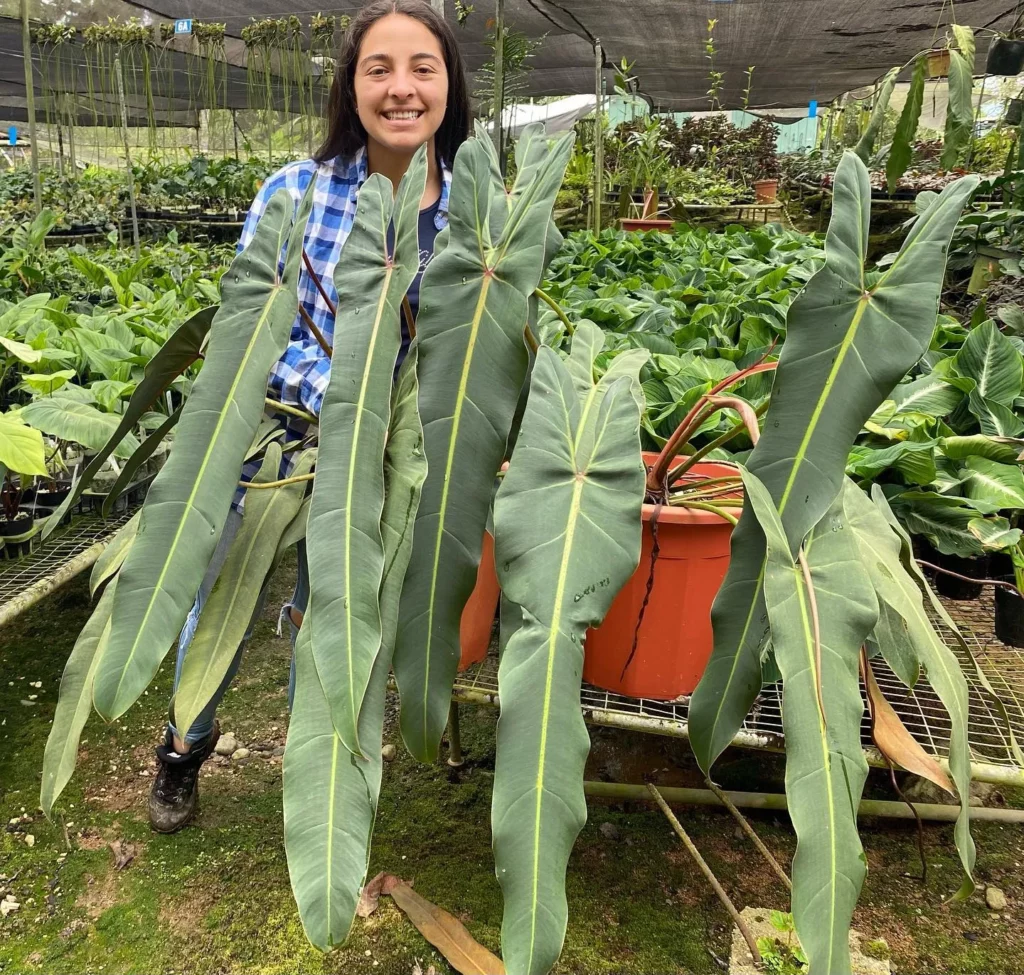

One of the rarest Philodendrons, it’s distinguished by its elongated, deep green leaves with a unique central rib.
- Leaf Color: Deep green.
- Leaf Size: Large.
- Growth Habit: Upright.
- Availability: Extremely rare and sought after.
Philodendron Warszewiczii



Known for its deeply lobed, fern-like leaves, this variety adds a touch of the tropics to any space.
- Leaf Color: Green.
- Leaf Size: Large.
- Growth Habit: Upright.
- Availability: Moderate.
Philodendron Tortum



Recognized for its twisted, curly leaves, this Philodendron brings a unique texture and appearance to collections.
- Leaf Color: Green.
- Leaf Size: Medium to large.
- Growth Habit: Upright.
- Availability: Less common.
Philodendron Serpens



Distinguished by its velvety green leaves and hairy petioles, this species adds a tactile element to plant collections.
- Leaf Color: Velvety green.
- Leaf Size: Medium.
- Growth Habit: Climbing.
- Availability: Rare.
Philodendron Radiatum
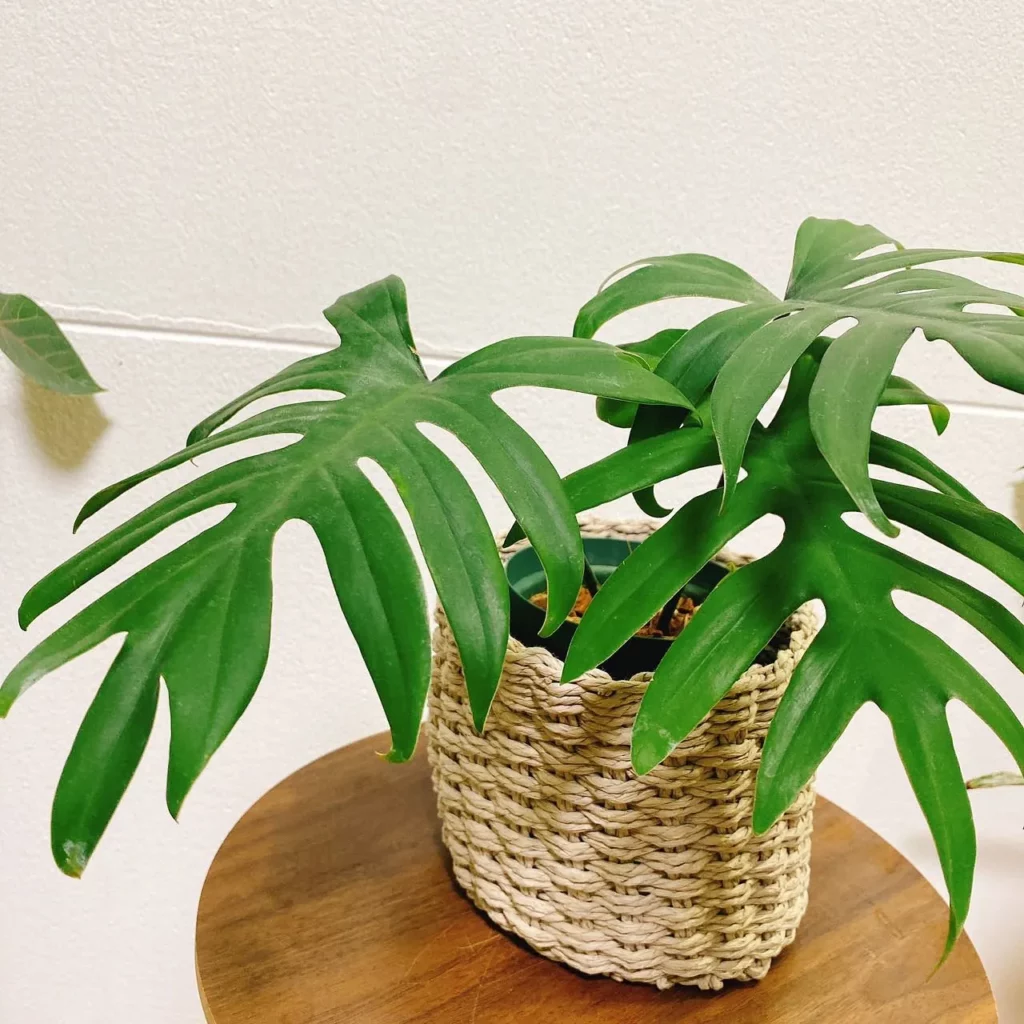
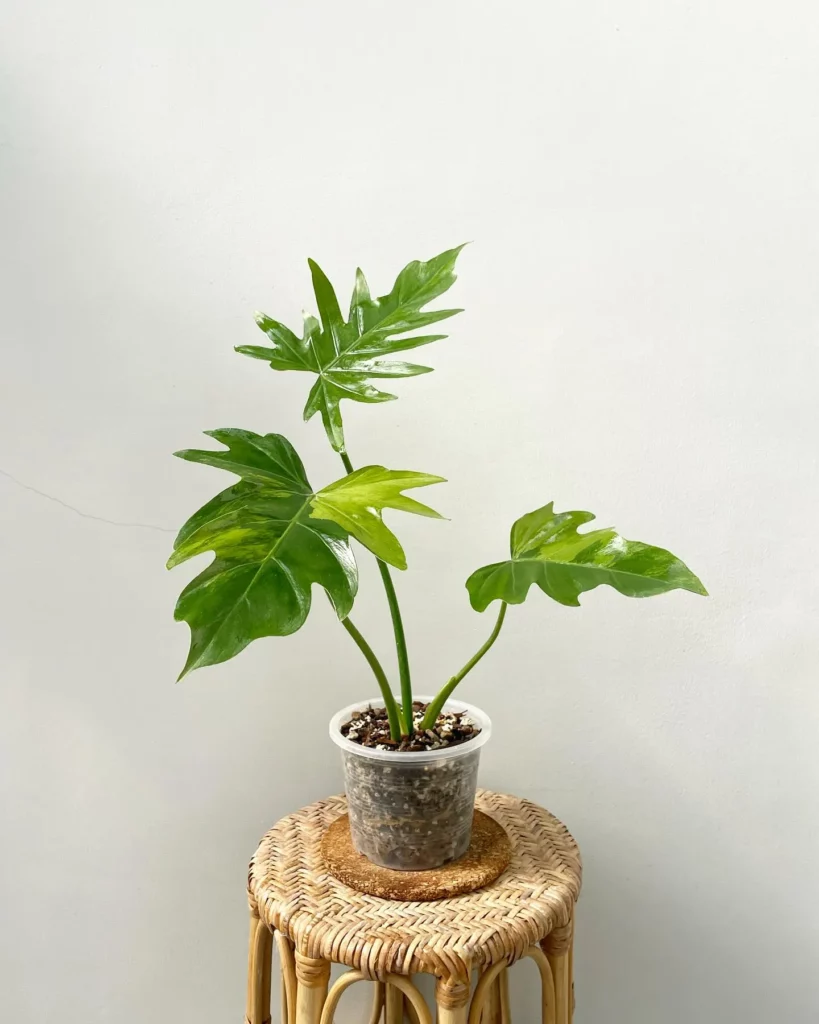
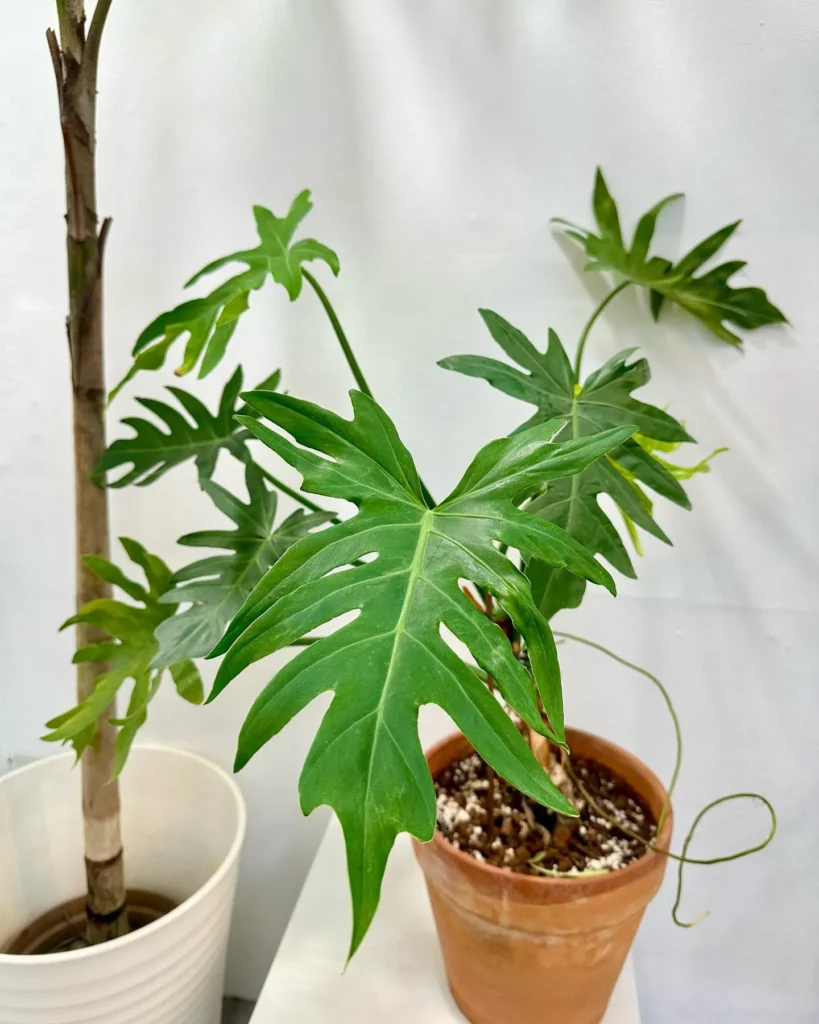
Characterized by its deeply lobed leaves, this species evokes a tropical ambiance.
- Leaf Color: Green.
- Leaf Size: Large.
- Growth Habit: Upright.
- Availability: Common.
Philodendron Pedatum



With its lobed, hand-shaped leaves, this Philodendron brings a unique aesthetic to plant collections.
- Leaf Color: Green.
- Leaf Size: Medium to large.
- Growth Habit: Climbing.
- Availability: Common.
Philodendron Deja Vu



This variety is known for its deeply serrated leaves, reminiscent of a fern, offering a unique texture.
- Leaf Color: Green.
- Leaf Size: Medium.
- Growth Habit: Upright.
- Availability: Common.
Philodendron Paraiso Verde
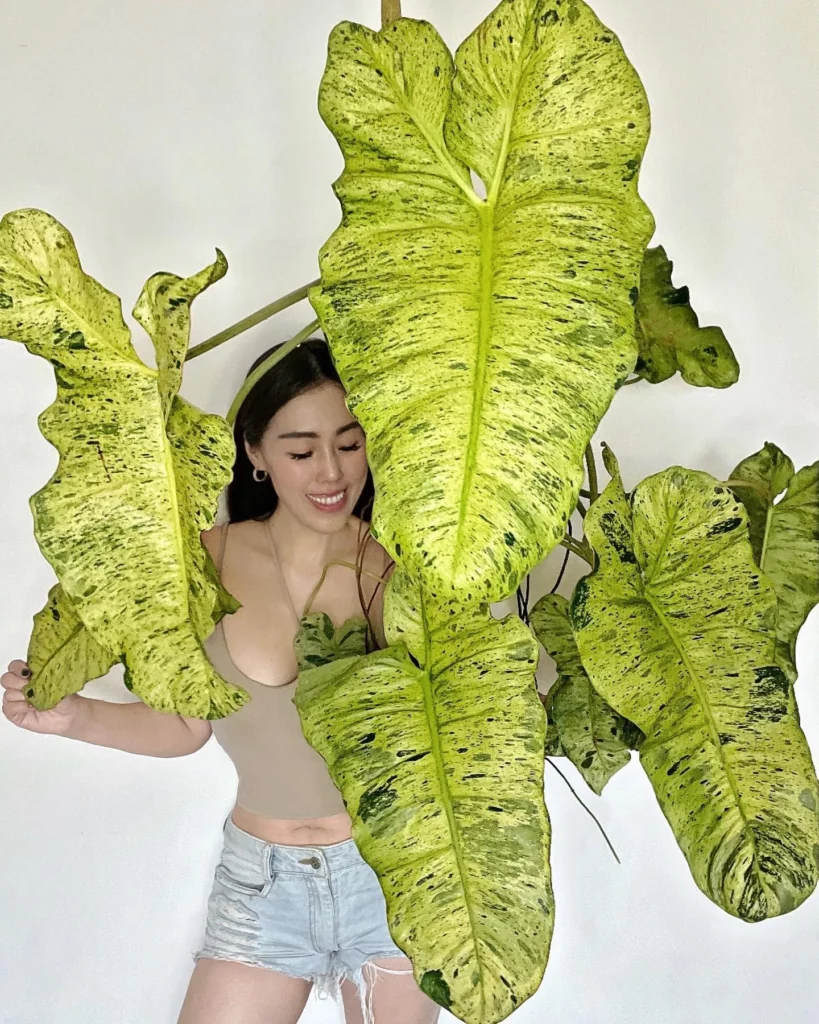


A vibrant Philodendron with variegated leaves showcasing a mix of green and yellow hues.
- Leaf Color: Variegated green and yellow.
- Leaf Size: Medium.
- Growth Habit: Vining.
- Availability: Less common.
Philodendron Autumn



As the name suggests, this variety features leaves that transition in color, reminiscent of autumn leaves, from reddish-orange to green.
- Leaf Color: Reddish-orange maturing to green.
- Leaf Size: Medium.
- Growth Habit: Upright.
- Availability: Common.
Philodendron Melanochrysum



This species is admired for its large, velvety leaves with a dark green color and prominent white veins, exuding a luxurious feel.
- Leaf Color: Dark green with white veins.
- Leaf Size: Large.
- Growth Habit: Climbing.
- Availability: Moderate to rare.
Philodendron White Wizard



A striking variety characterized by its deep green leaves with stunning white variegation, creating a magical appearance.
- Leaf Color: Deep green with white variegation.
- Leaf Size: Medium to large.
- Growth Habit: Upright.
- Availability: Rare.
Philodendron Golden Goddess



Featuring luminous, light green leaves, this Philodendron shines brightly in any collection.
- Leaf Color: Luminous light green.
- Leaf Size: Medium.
- Growth Habit: Upright.
- Availability: Common.
Philodendron Florida Ghost



Unique for its new leaves which emerge a ghostly white and gradually turn green as they mature, giving it its spooky name.
- Leaf Color: New leaves are white, maturing to green.
- Leaf Size: Medium.
- Growth Habit: Upright.
- Availability: Moderate to rare.
Philodendron Green Princess



A compact Philodendron variety with glossy, deep green leaves. It’s perfect for smaller spaces while still providing a tropical touch.
- Leaf Color: Glossy deep green.
- Leaf Size: Medium.
- Growth Habit: Compact and upright.
- Availability: Common.
Philodendron Imperial Green

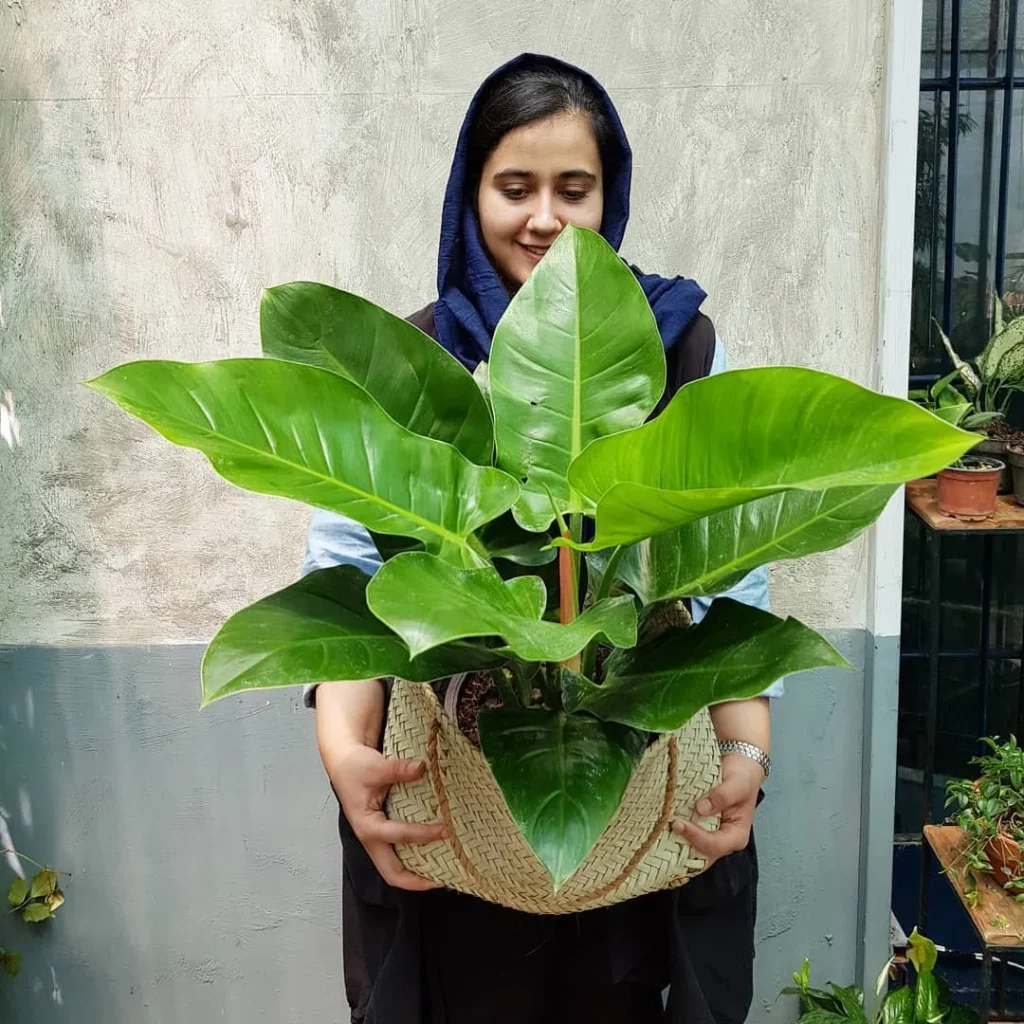
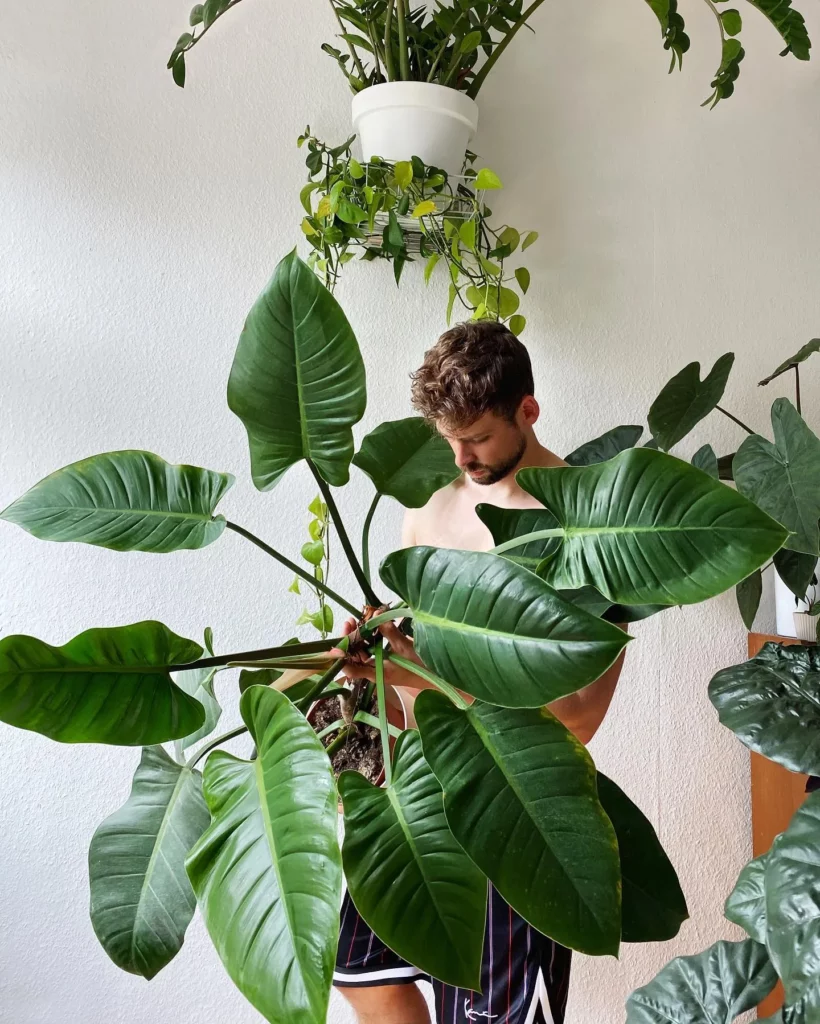
Characterized by its large, glossy, deep green leaves, this variety adds a regal touch to any space.
- Leaf Color: Glossy deep green.
- Leaf Size: Large.
- Growth Habit: Upright.
- Availability: Common.
Philodendron Atom



Known for its dense growth and deeply lobed leaves, it brings a bushy, tropical feel to interiors.
- Leaf Color: Green.
- Leaf Size: Small to medium.
- Growth Habit: Compact and bushy.
- Availability: Common.
Philodendron Congo Green



This variety stands out with its broad, glossy leaves, giving interiors a lush, green appearance.
- Leaf Color: Glossy deep green.
- Leaf Size: Large.
- Growth Habit: Upright.
- Availability: Common.
Philodendron Florida Beauty
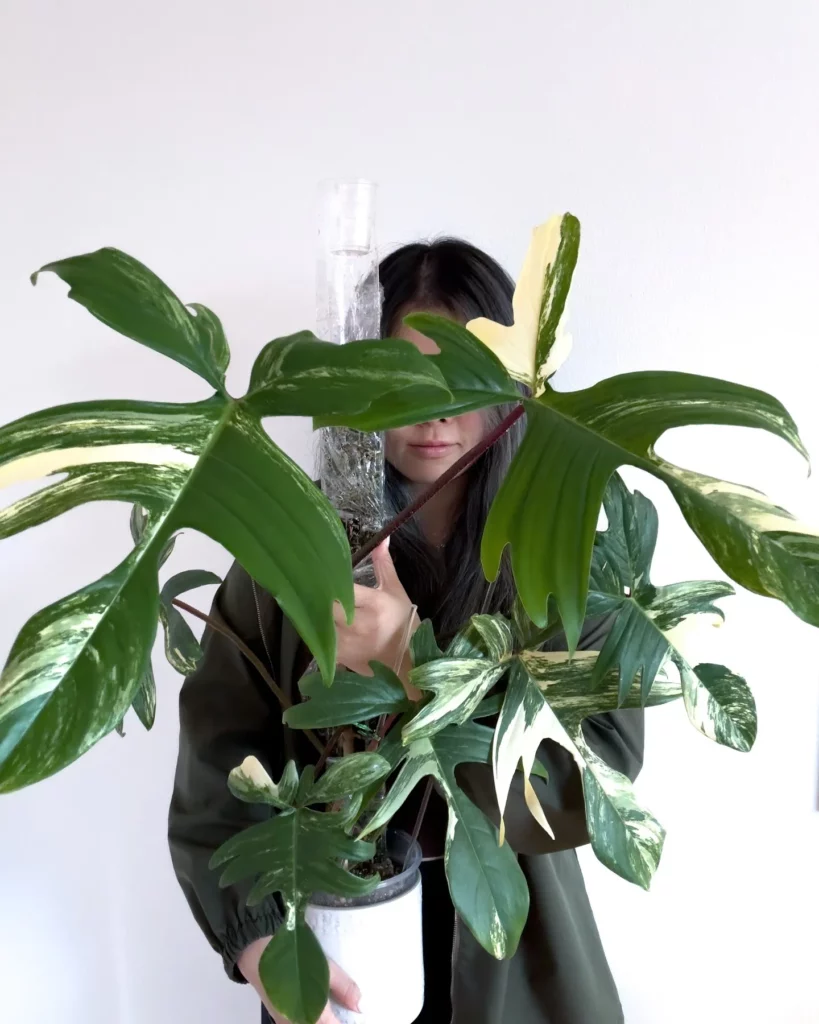
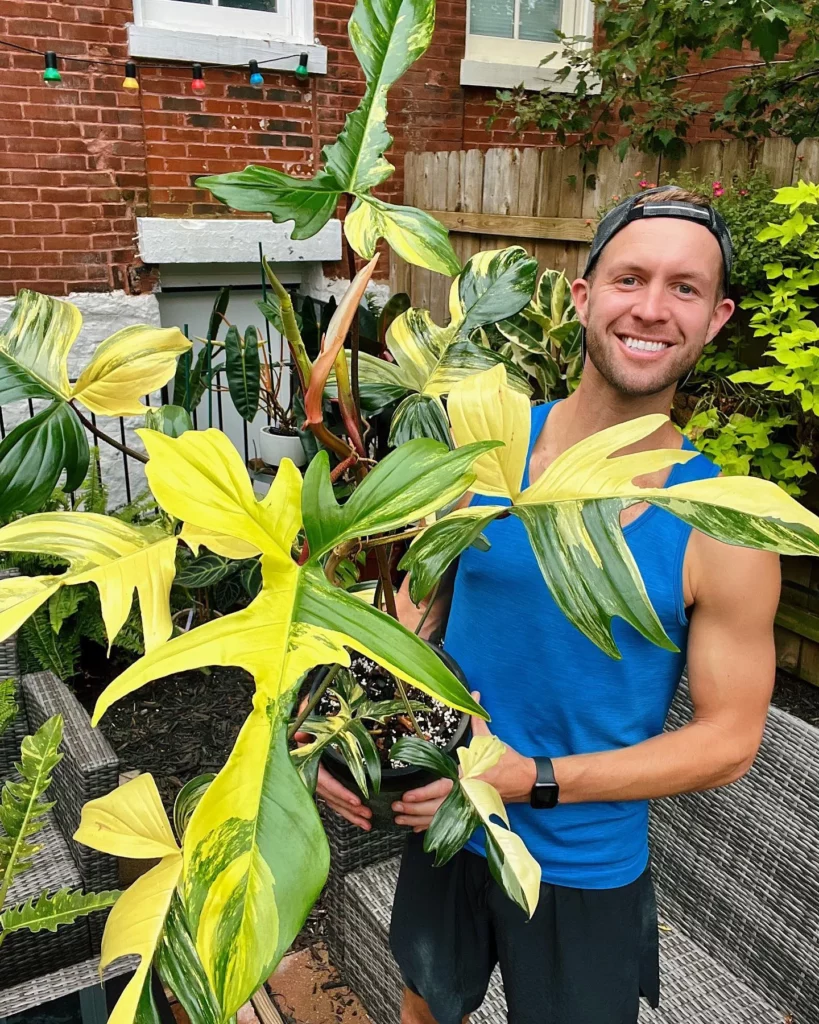
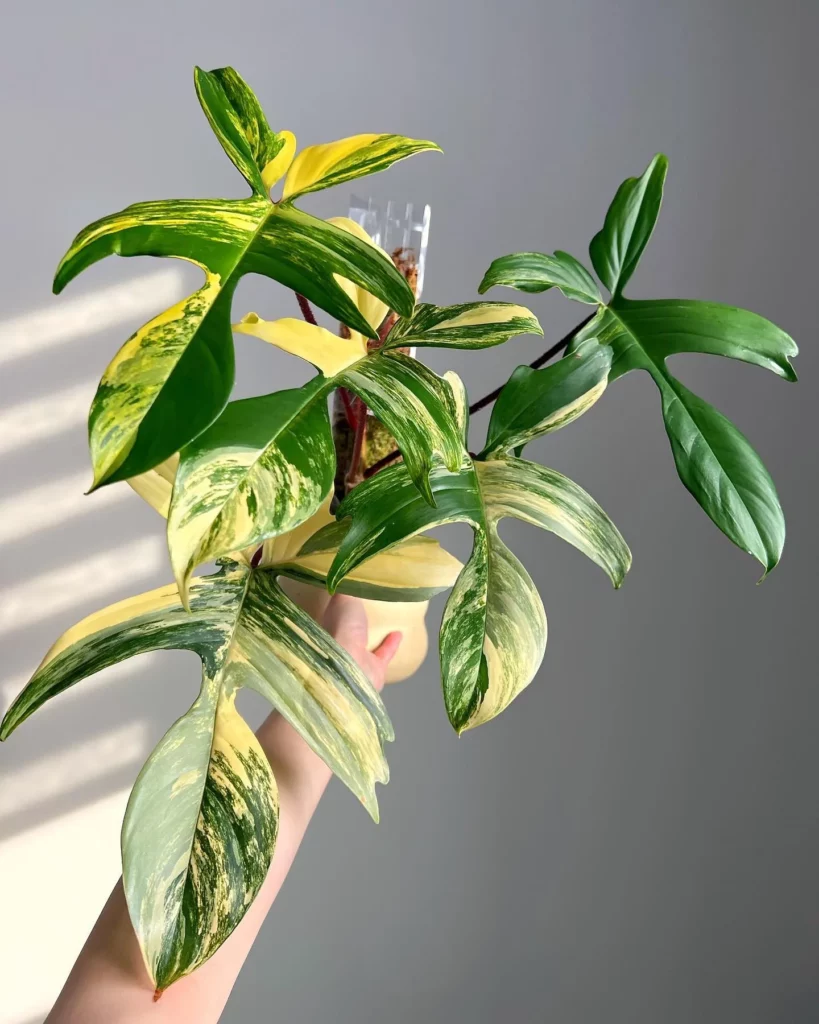
With its unique variegated leaves displaying a mix of green and yellow, this Philodendron is a true beauty.
- Leaf Color: Variegated green and yellow.
- Leaf Size: Medium to large.
- Growth Habit: Upright.
- Availability: Rare.
Philodendron Jose Buono



Notable for its massive leaves with striking variegation, this Philodendron is a centerpiece in any collection.
- Leaf Color: Green with cream to white variegation.
- Leaf Size: Very large.
- Growth Habit: Upright.
- Availability: Rare.
Philodendron Silver Queen



This variety stands out with its green leaves showcasing elegant silver stripes, adding a touch of regality to collections.
- Leaf Color: Green with silver stripes.
- Leaf Size: Medium.
- Growth Habit: Climbing.
- Availability: Moderate.
Philodendron Dark Lord



With its deep green, almost black leaves and vibrant red undersides, this Philodendron is truly a dramatic presence.
- Leaf Color: Deep green to black with red undersides.
- Leaf Size: Large.
- Growth Habit: Upright.
- Availability: Less common.
Philodendron Florida Compacta



A variant of the Florida species, it’s known for its compact growth and deeply lobed leaves.
- Leaf Color: Green.
- Leaf Size: Medium to large.
- Growth Habit: Compact and upright.
- Availability: Moderate.
Philodendron Midnight Green
This variety is recognized for its dark green, almost black leaves, giving it a mysterious aura.
- Leaf Color: Dark green to black.
- Leaf Size: Medium to large.
- Growth Habit: Upright.
- Availability: Less common.
Philodendron Pink Princess Splash (Philodendron erubescens)
A variant of the Pink Princess, it features green leaves splashed with vibrant pink variegation.
- Leaf Color: Green with pink splashes.
- Leaf Size: Medium.
- Growth Habit: Upright.
- Availability: Rare.
Philodendron Birkin Splash



A twist on the Birkin variety, it has the signature white-striped leaves with additional splashes of color.
- Leaf Color: Green with white stripes and splashes.
- Leaf Size: Medium.
- Growth Habit: Upright.
- Availability: Less common.
Philodendron El Choco Red


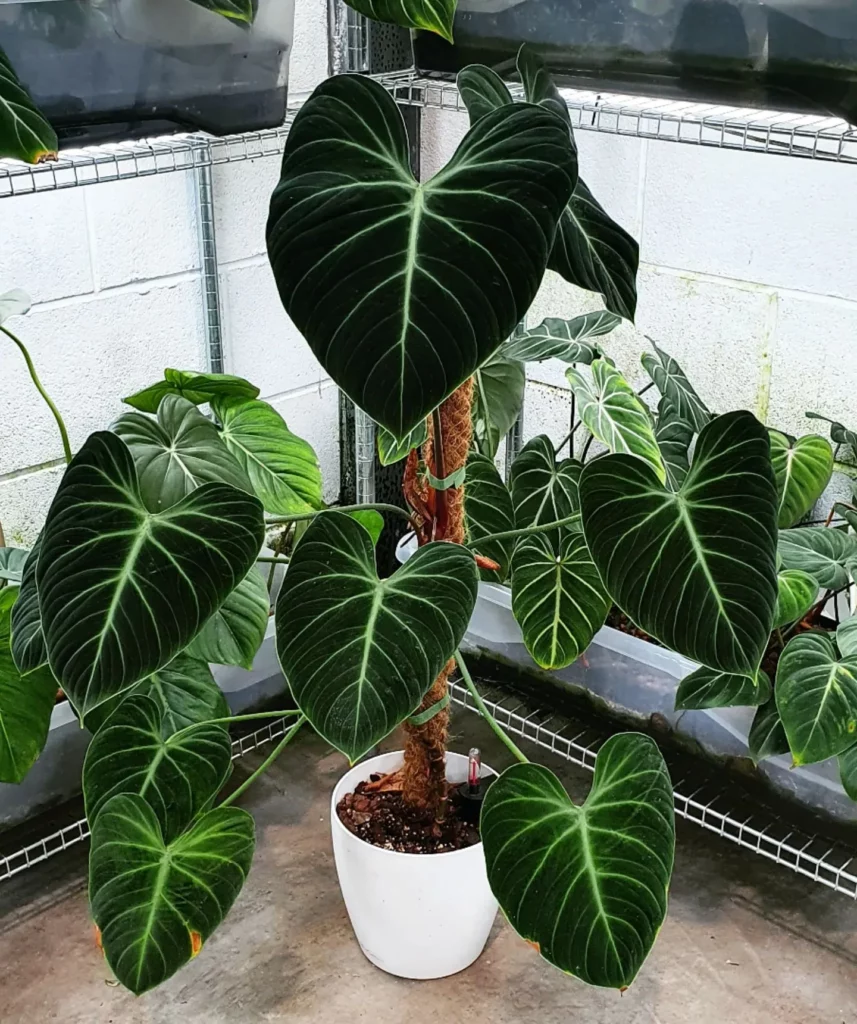
Distinctive for its deep red leaves, this Philodendron adds a warm, tropical ambiance to spaces.
- Leaf Color: Deep red.
- Leaf Size: Medium to large.
- Growth Habit: Upright.
- Availability: Rare.
Philodendron Silver Cloud



Characterized by its green leaves with a silvery sheen, it brings a touch of luminosity to collections.
- Leaf Color: Green with a silvery sheen.
- Leaf Size: Medium.
- Growth Habit: Climbing.
- Availability: Moderate.
Philodendron Florida Compacta Mini (Philodendron hederaceum)
A miniature version of the Florida Compacta, it’s perfect for those looking for the same aesthetic in a smaller size.
- Leaf Color: Green.
- Leaf Size: Small.
- Growth Habit: Compact and upright.
- Availability: Moderate.
Philodendron Pink Princess Dwarf (Philodendron erubescens)
A smaller variant of the iconic Pink Princess, it offers the same stunning pink variegation in a compact form.
- Leaf Color: Dark green with pink variegation.
- Leaf Size: Small.
- Growth Habit: Compact and upright.
- Availability: Rare.
Philodendron Pedatum Green
This variant of the Pedatum is known for its vibrant green, hand-shaped leaves that add a touch of nature’s intricacy.
- Leaf Color: Vibrant green.
- Leaf Size: Medium to large.
- Growth Habit: Climbing.
- Availability: Common.
Philodendron Burle Marx Fantasy (Philodendron ‘Burle Marx Fantasy’)
A hybrid known for its elongated, silvery-green leaves, this Philodendron pays homage to the landscape artist Roberto Burle Marx.
- Leaf Color: Silvery-green.
- Leaf Size: Medium.
- Growth Habit: Upright.
- Availability: Less common.
Philodendron Congo Green Queen
A variant of the Congo series, it features broader, glossier leaves that exude a regal charm.
- Leaf Color: Glossy deep green.
- Leaf Size: Large.
- Growth Habit: Upright.
- Availability: Common.
Philodendron Imperial Red Compacta
A compact version of the Imperial Red, this variant offers the same deep red to burgundy leaves in a smaller size.
- Leaf Color: Deep red to burgundy.
- Leaf Size: Medium.
- Growth Habit: Compact and upright.
- Availability: Common.
Philodendron Gloriosum Mini
A miniature version of the renowned Gloriosum, it boasts the same velvety green leaves with white veins in a more manageable size.
- Leaf Color: Green with white veins.
- Leaf Size: Small to medium.
- Growth Habit: Creeping.
- Availability: Moderate.
Philodendron Lemon Lime Compacta
A compact version of the Lemon Lime, it brings the same neon-green vibrancy in a smaller form, perfect for tabletops.
- Leaf Color: Neon-green.
- Leaf Size: Small.
- Growth Habit: Compact and trailing.
- Availability: Common.
Philodendron Silver Sword Mini (Philodendron hastatum)
A miniature version of the Silver Sword, it offers the signature silvery-blue leaves in a more compact size.
- Leaf Color: Silvery-blue.
- Leaf Size: Small.
- Growth Habit: Climbing.
- Availability: Moderate.
Philodendron Florida Ghost Mini (Philodendron pedatum ‘Florida Ghost Mini’)
A smaller variant of the Florida Ghost, it showcases the same ghostly white new leaves that mature to green.
- Leaf Color: New leaves are white, maturing to green.
- Leaf Size: Small to medium.
- Growth Habit: Upright.
- Availability: Less common.
Philodendron Micans Variegated (Philodendron micans ‘Variegated’)
A variegated form of the Micans, it stands out with its velvety leaves that display a blend of green, yellow, and sometimes pink hues.
- Leaf Color: Variegated green, yellow, and pink.
- Leaf Size: Medium.
- Growth Habit: Trailing.
- Availability: Rare.
Philodendron Red Emerald Compacta (Philodendron erubescens ‘Red Emerald Compacta’)
A compact variant of the Red Emerald, it boasts the same dark green leaves with a reddish underside in a more manageable size.
- Leaf Color: Dark green with a reddish underside.
- Leaf Size: Medium.
- Growth Habit: Compact and upright.
- Availability: Common.
Philodendron Pink Princess Variegated (Philodendron erubescens ‘Pink Princess Variegated’)
A variegated twist on the iconic Pink Princess, this variant showcases leaves with a more pronounced blend of green, pink, and white.
- Leaf Color: Green, pink, and white variegation.
- Leaf Size: Medium.
- Growth Habit: Upright.
- Availability: Very rare.
Philodendron Golden Dragon (Philodendron ‘Golden Dragon’)
With its deeply lobed, golden-green leaves, this Philodendron variety adds a mythical touch to plant collections.
- Leaf Color: Golden-green.
- Leaf Size: Medium to large.
- Growth Habit: Upright.
- Availability: Moderate.
Philodendron Royal Queen
Boasting rich, burgundy-red leaves, this variety adds a royal charm to any plant ensemble.
- Leaf Color: Burgundy-red.
- Leaf Size: Medium.
- Growth Habit: Upright.
- Availability: Less common.
Philodendron Florida Beauty Green (Philodendron hederaceum ‘Florida Beauty Green’)
A green variant of the Florida Beauty, it’s known for its deeply lobed leaves and upright growth.
- Leaf Color: Green.
- Leaf Size: Medium to large.
- Growth Habit: Upright.
- Availability: Moderate.
Philodendron Tahiti
Characterized by its split, lance-shaped leaves, this variety brings a tropical vibe reminiscent of the island it’s named after.
- Leaf Color: Green.
- Leaf Size: Medium.
- Growth Habit: Upright.
- Availability: Moderate.
Philodendron Emerald Duke
Known for its glossy, emerald-green leaves, this Philodendron is a jewel in any collection.
- Leaf Color: Glossy emerald-green.
- Leaf Size: Medium.
- Growth Habit: Upright.
- Availability: Common.
Philodendron Silver Sword XL (Philodendron hastatum ‘Silver Sword XL’)
An extra-large version of the Silver Sword, it offers the same beautiful silvery-blue leaves but on a grander scale.
- Leaf Color: Silvery-blue.
- Leaf Size: Very large.
- Growth Habit: Climbing.
- Availability: Less common.
Philodendron Fiddleleaf
With its unique fiddle-shaped leaves, this variety adds a musical touch to plant collections.
- Leaf Color: Green.
- Leaf Size: Large.
- Growth Habit: Upright.
- Availability: Moderate.
Philodendron Prince of Orange Compacta
A compact version of the Prince of Orange, it showcases the same transition of colors from orange to green in a more manageable size.
- Leaf Color: Starts as orange, matures to green.
- Leaf Size: Medium.
- Growth Habit: Compact and upright.
- Availability: Less common.
Philodendron Pink Princess White Knight (Philodendron erubescens ‘Pink Princess White Knight’)
A hybrid of the Pink Princess and White Knight, this variety boasts leaves with a mix of green, pink, and white variegation.
- Leaf Color: Green, pink, and white variegation.
- Leaf Size: Medium.
- Growth Habit: Upright.
- Availability: Very rare.
Philodendron Painted Lady Hybrid
A hybrid that combines the beauty of the Painted Lady, it showcases elongated leaves with unique yellow and green patterns.
- Leaf Color: Green with yellow patterns.
- Leaf Size: Medium to large.
- Growth Habit: Upright.
- Availability: Moderate.
Philodendron Moonlight Scandens)
A cross between the Moonlight and Scandens varieties, this Philodendron features heart-shaped luminous light green leaves.
- Leaf Color: Luminous light green.
- Leaf Size: Medium.
- Growth Habit: Trailing or climbing.
- Availability: Moderate.
Philodendron Silver Stripe Mini
A miniature version of the Silver Stripe, it offers the same elegant green leaves with subtle silver stripes.
- Leaf Color: Green with subtle silver stripes.
- Leaf Size: Small.
- Growth Habit: Vining.
- Availability: Moderate.
Philodendron Golden Violin
Boasting elongated, glossy golden-green leaves, this Philodendron variety resonates with nature’s beauty.
- Leaf Color: Glossy golden-green.
- Leaf Size: Medium to long.
- Growth Habit: Upright.
- Availability: Moderate.
Philodendron Paraiso Verde Dwarf
A smaller variant of the Paraiso Verde, it offers the same vibrant variegated leaves of green and yellow.
- Leaf Color: Variegated green and yellow.
- Leaf Size: Small.
- Growth Habit: Compact and vining.
- Availability: Less common.
Philodendron Autumn Beauty Mini
A miniature version of the Autumn Philodendron, it showcases leaves that transition in color from reddish-orange to green.
- Leaf Color: Reddish-orange maturing to green.
- Leaf Size: Small.
- Growth Habit: Compact and upright.
- Availability: Moderate.
Philodendron Golden Goddess Mini
A compact version of the Golden Goddess, this variety exudes the same luminous, light green charm in a smaller form.
- Leaf Color: Luminous light green.
- Leaf Size: Small.
- Growth Habit: Compact and upright.
- Availability: Common.
Philodendron Radiatum XL
An extra-large version of the Radiatum, it boasts the same deeply lobed leaves but on a grander scale.
- Leaf Color: Green.
- Leaf Size: Very large.
- Growth Habit: Upright.
- Availability: Moderate.
Philodendron Imperial Green XL
An extra-large variant of the Imperial Green, it showcases the same glossy, deep green leaves in a more majestic form.
- Leaf Color: Glossy deep green.
- Leaf Size: Very large.
- Growth Habit: Upright.
- Availability: Common.
Philodendron Black Cardinal Mini
A miniature form of the Black Cardinal, it offers the same dark green to almost black leaves in a smaller size.
- Leaf Color: Dark green to black.
- Leaf Size: Small.
- Growth Habit: Compact and upright.
- Availability: Moderate.
Philodendron Lemon Lime XL (Philodendron hederaceum ‘Lemon Lime XL’)
An extra-large version of the Lemon Lime, it boasts the same vibrant neon-green leaves but on a grander scale.
- Leaf Color: Neon-green.
- Leaf Size: Very large.
- Growth Habit: Upright.
- Availability: Common.
Philodendron Florida Compacta Mariposa (Philodendron hederaceum ‘Florida Compacta Mariposa’)
A variant of the Florida Compacta, “Mariposa” offers beautifully lobed leaves with a unique butterfly-like appearance.
- Leaf Color: Green.
- Leaf Size: Medium.
- Growth Habit: Upright.
- Availability: Less common.
Philodendron Congo Green Queen XL
An extra-large version of the Congo Green Queen, it provides the same broad, glossy leaves, but in a more commanding presence.
- Leaf Color: Glossy deep green.
- Leaf Size: Very large.
- Growth Habit: Upright.
- Availability: Moderate.






Where can I purchase one or. Two of these plants.
Try Etsy, Logee’s online Home Depot should have the Birkin.
What’s the name of the tall orange and green plant on the picture of this article? Is that real?
The Philodendron Prince of Orange?
I really love all these plants but are very prisie in South Africa… Do you export